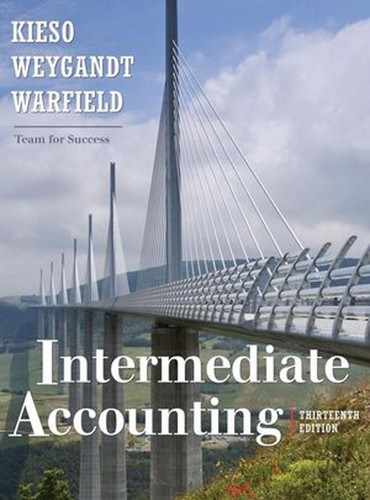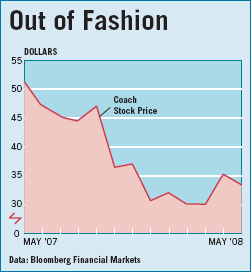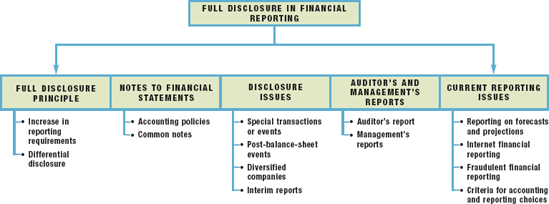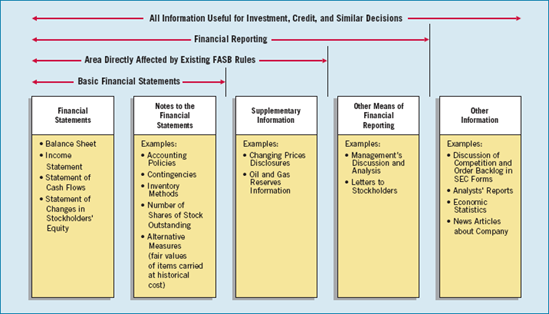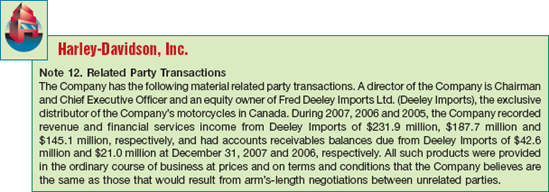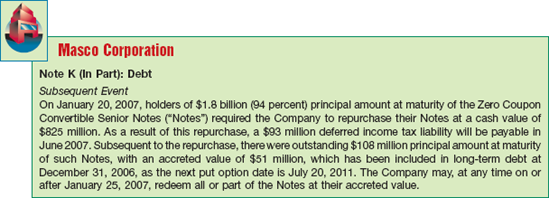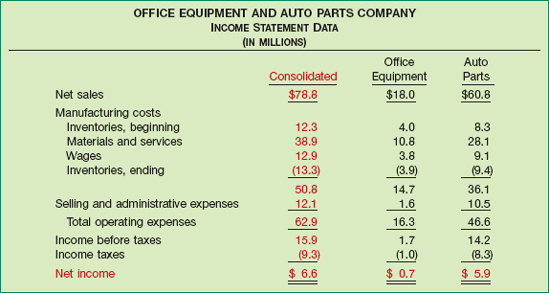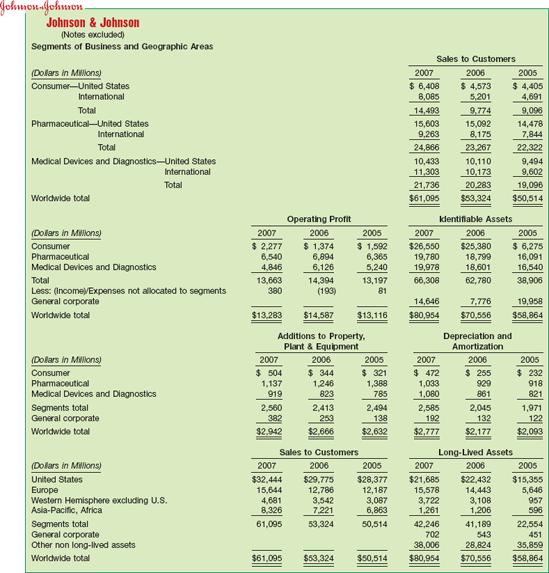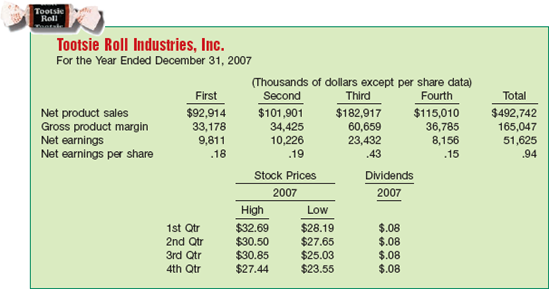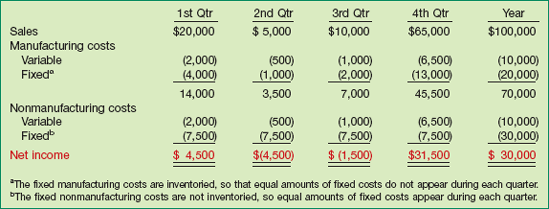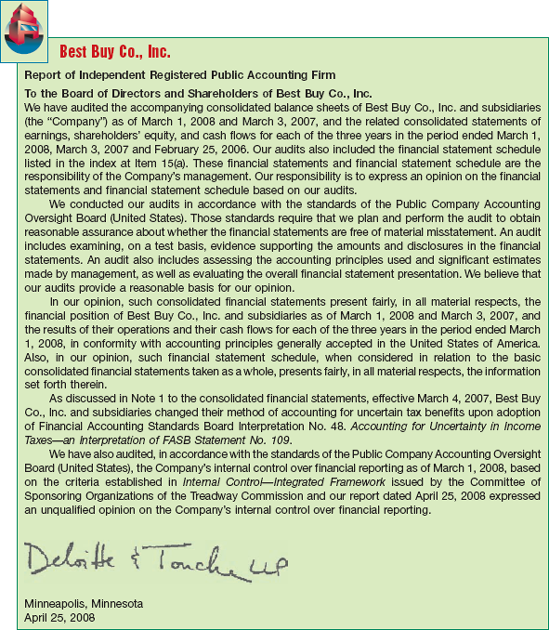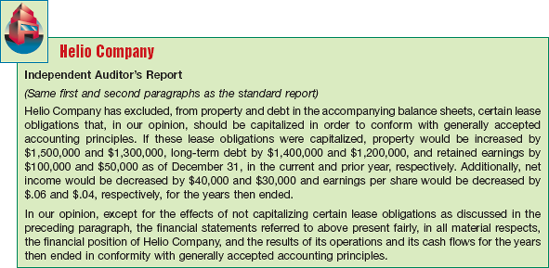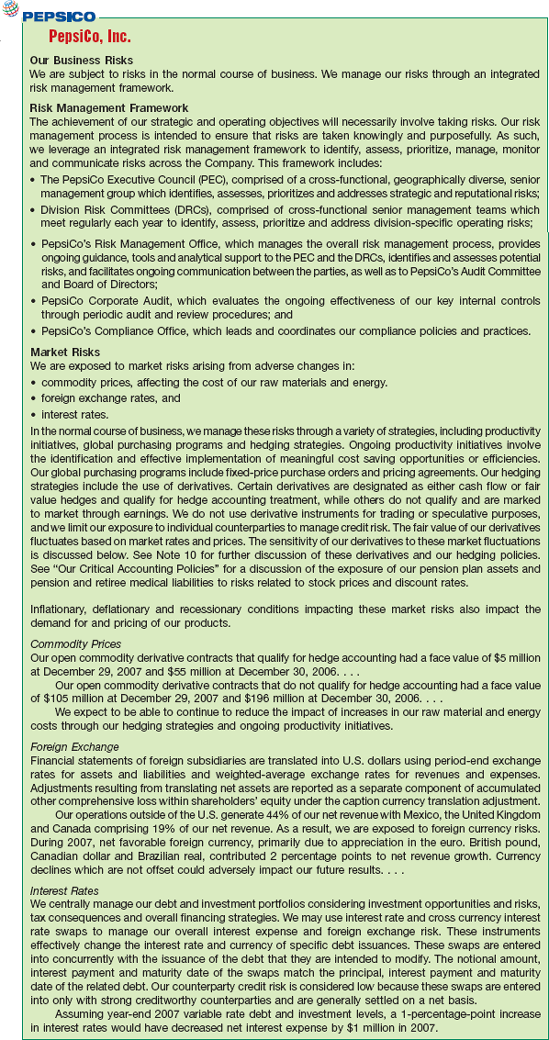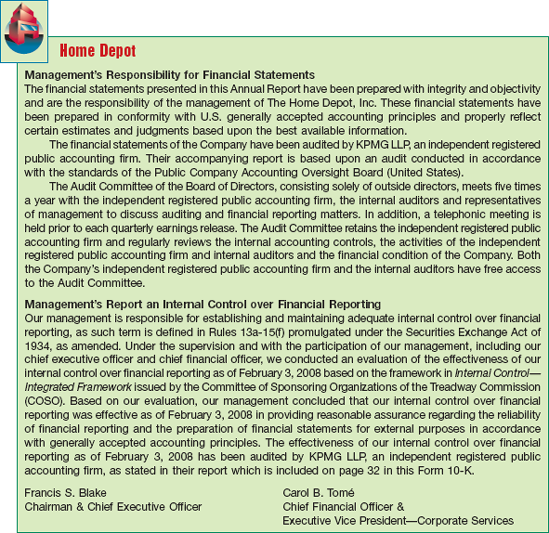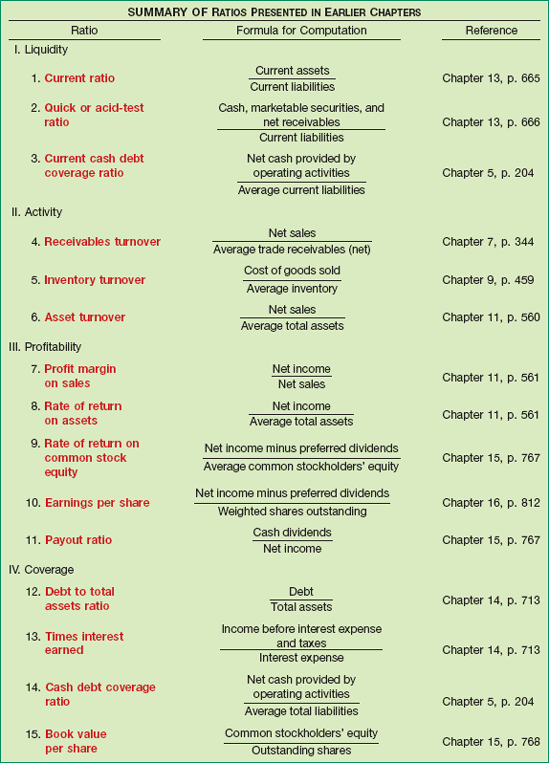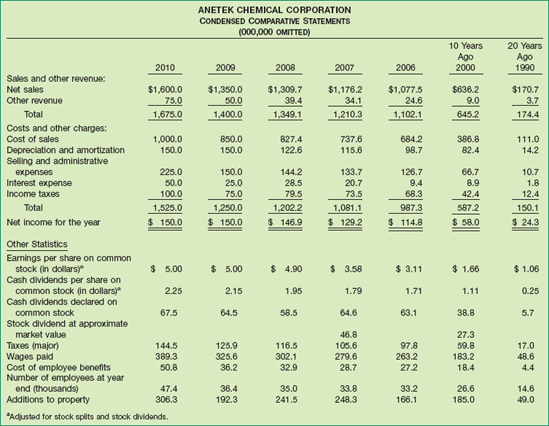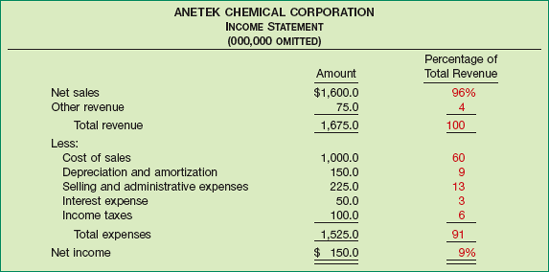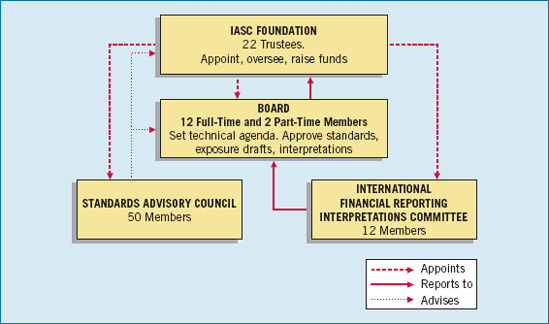After studying this chapter, you should be able to:
FASB Concepts Statement No. 1 notes that some useful information is best provided in the financial statements, and some is best provided by means other than in financial statements. For example, earnings and cash flows are readily available in financial statements—but investors might do better to look at comparisons to other companies in the same industry, found in news articles or brokerage house reports.
FASB rules directly affect financial statements, notes to the financial statements, and supplementary information. Other types of information found in the annual report, such as management's discussion and analysis, are not subject to FASB rules. Illustration 24-1 indicates the various types of financial information.
As Chapter 2 indicated, the profession has adopted a full disclosure principle. The full disclosure principle calls for financial reporting of any financial facts significant enough to influence the judgment of an informed reader. In some situations, the benefits of disclosure may be apparent but the costs uncertain. In other instances, the costs may be certain but the benefits of disclosure not as apparent.
For example, recently, the SEC required companies to provide expanded disclosures about their contractual obligations. In light of the off-balance-sheet accounting frauds at companies like Enron, the benefits of these expanded disclosures seem fairly obvious to the investing public. While no one has documented the exact costs of disclosure in these situations, they would appear to be relatively small.
On the other hand, the cost of disclosure can be substantial in some cases and the benefits difficult to assess. For example, at one time the Wall Street Journal reported that if segment reporting were adopted, a company like Fruehauf would have had to increase its accounting staff 50 percent, from 300 to 450 individuals. In this case, the cost of disclosure can be measured, but the benefits are less well defined.
Some even argue that the reporting requirements are so detailed and substantial that users have a difficult time absorbing the information. These critics charge the profession with engaging in information overload.
Financial disasters at Microstrategy, PharMor, WorldCom, and AIG highlight the difficulty of implementing the full disclosure principle. They raise the issue of why investors were not aware of potential problems: Was the information these companies presented not comprehensible? Was it buried? Was it too technical? Was it properly presented and fully disclosed as of the financial statement date, but the situation later deteriorated? Or was it simply not there? In the following sections, we describe the elements of high-quality disclosure that will enable companies to avoid these disclosure pitfalls.
Disclosure requirements have increased substantially. One survey showed that the size of many companies' annual reports is growing in response to demands for increased transparency. For example, annual report page counts ranged from 70 pages for Gateway up to a whopping 244 pages in Eastman Kodak's annual report. Compared to prior years' reports, the percentage increase in pages ranged from 17 percent at IBM to over 80 percent at Siebel Systems.[425] This result is not surprising; as illustrated throughout this textbook, the FASB has issued many pronouncements in the last 10 years that have substantial disclosure provisions.
The reasons for this increase in disclosure requirements are varied. Some of them are:
Complexity of the Business Environment. The increasing complexity of business operations magnifies the difficulty of distilling economic events into summarized reports. Such areas as derivatives, leasing, business combinations, pensions, financing arrangements, revenue recognition, and deferred taxes are complex. As a result, companies extensively use notes to the financial statements to explain these transactions and their future effects.
Necessity for Timely Information. Today, more than ever before, users are demanding information that is current and predictive. For example, users want more complete interim data. Also, the SEC recommends published financial forecasts, long avoided and even feared by management.
Accounting as a Control and Monitoring Device. The government has recently sought public disclosure of such phenomena as management compensation, off-balance-sheet financing arrangements, and related party transactions. An "Enronitis" concern is expressed in many of these newer disclosure requirements, and the SEC has selected accountants and auditors as the agents to assist in controlling and monitoring these concerns.
A trend toward differential disclosure is also occurring. For example, the SEC requires that companies report to it certain substantive information that is not found in annual reports to stockholders. Likewise, the FASB, recognizing that certain disclosure requirements are costly and unnecessary for certain companies, has eliminated reporting requirements for nonpublic enterprises in such areas as fair value of financial instruments and segment reporting.[426]
As we discussed in the opening story, financial disclosure is one of a number of institutional features that contribute to vibrant security markets. In fact, a recent study of disclosure and other mechanisms (such as civil lawsuits and criminal sanctions) found that good disclosure is the most important contributor to a vibrant market.
The study, which compared disclosure and other legal and regulatory elements across 49 countries, found that countries with the best disclosure laws have the biggest stock markets. Countries with more successful market environments also tend to have regulations that make it relatively easy for private investors to sue corporations that provide bad information. That is, while criminal sanctions can be effective in some circumstances, disclosure and other legal and regulatory elements encouraging good disclosure are the most important determinants of highly liquid and deep securities markets.
These findings hold for nations in all stages of economic development, with particular importance for nations that are in the early stages of securities regulation. The lesson: Disclosure is good for your market.
Source: Rebecca Christie, "Study: Disclosure at Heart of Effective Securities Laws," Wall Street Journal Online (August 11, 2003).
Some still complain that the FASB has not gone far enough. They note that certain types of companies (small or nonpublic) should not have to follow complex GAAP requirements such as those for deferred income taxes, leases, or pensions. This issue, often referred to as "big GAAP versus little GAAP," continues to be controversial. The FASB takes the position that there should be one set of GAAP, except in unusual situations.[427]
As you know from your study of this textbook, notes are an integral part of the financial statements of a business enterprise. However, readers of financial statements often overlook them because they are highly technical and often appear in small print. Notes are the means of amplifying or explaining the items presented in the main body of the statements. They can explain in qualitative terms information pertinent to specific financial statement items. In addition, they can provide supplementary data of a quantitative nature to expand the information in the financial statements. Notes also can explain restrictions imposed by financial arrangements or basic contractual agreements. Although notes may be technical and difficult to understand, they provide meaningful information for the user of the financial statements.
Accounting policies are the specific accounting principles and methods a company currently uses and considers most appropriate to present fairly its financial statements. GAAP states that information about the accounting policies adopted by a reporting entity is essential for financial statement users in making economic decisions. It recommended that companies should present as an integral part of the financial statements a statement identifying the accounting policies adopted and followed by the reporting entity. Companies should present the disclosure as the first note or in a separate Summary of Significant Accounting Policies section preceding the notes to the financial statements.
The Summary of Significant Accounting Policies answers such questions as: What method of depreciation is used on plant assets? What valuation method is employed on inventories? What amortization policy is followed in regard to intangible assets? How are marketing costs handled for financial reporting purposes?
Refer to Appendix 5B, pages 210–238, for an illustration of note disclosure of accounting policies (Note 1) and other notes accompanying the audited financial statements of The Procter & Gamble Company. Illustration 24-2 shows another example, from Tootsie Roll Industries.
Analysts examine carefully the summary of accounting policies to determine whether a company is using conservative or liberal accounting practices. For example, depreciating plant assets over an unusually long period of time is considered liberal. Using LIFO inventory valuation in a period of inflation is generally viewed as conservative.
Companies that fail to adopt high-quality reporting policies may be heavily penalized by the market. For example, when Microstrategy disclosed that it would restate prior-year results due to use of aggressive revenue recognition policies, its share price dropped over 60 percent in one day. Investors viewed Microstrategy's quality of earnings as low.
We have discussed many of the notes to the financial statements throughout this textbook, and will discuss others more fully in this chapter. The more common are as follows.
In earlier chapters we discussed the disclosures listed above. The following sections of this chapter illustrate four additional disclosures of significance—special transactions or events, subsequent events, segment reporting, and interim reporting.

Often, note disclosures are needed to give a complete picture of a company's financial position. A good example of such disclosures is the required disclosure of debt triggers that may be buried in financing arrangements. These triggers can require a company to pay off a loan immediately if the debt rating collapses; they are one of the reasons Enron crumbled so quickly. But few Enron stockholders knew about the debt triggers until the gun had gone off. Companies are also disclosing more about their bank credit lines, liquidity, and any special purpose entities. (The latter were major villains in the Enron drama.)
How can you get better informed about note disclosures that may contain important information related to your investments? Beyond your study in this class, a good web resource for understanding the contents of note disclosures is http://www.footnoted.org/. This site highlights "the things companies bury in their SEC filings." It notes that company reports are more complete of late, but only the largest companies are preparing documents that are readable. As the editor of the site noted, "[some companies] are being dragged kicking and screaming into plain English."
Source: Gretchen Morgenson, "Annual Reports: More Pages, But Better?" New York Times (March 17, 2002), and D. Stead, "The Secrets in SEC Filings," BusinessWeek (August 25, 2008), p. 12.
Related-party transactions, errors and fraud, and illegal acts pose especially sensitive and difficult problems. The accountant/auditor who has responsibility for reporting on these types of transactions must take care to properly balance the rights of the reporting company and the needs of users of the financial statements.
Related-party transactions arise when a company engages in transactions in which one of the parties has the ability to significantly influence the policies of the other. They may also occur when a nontransacting party has the ability to influence the policies of the two transacting parties.[428] Competitive, free-market dealings may not exist in related-party transactions, and so an "arm's-length" basis cannot be assumed. Transactions such as borrowing or lending money at abnormally low or high interest rates, real estate sales at amounts that differ significantly from appraised value, exchanges of nonmonetary assets, and transactions involving enterprises that have no economic substance ("shell corporations") suggest that related parties may be involved.
In order to make adequate disclosure, companies should report the economic substance, rather than the legal form, of these transactions. GAAP requires the following disclosures of material related-party transactions. [1]
The nature of the relationship(s) involved.
A description of the transactions (including transactions to which no amounts or nominal amounts were ascribed) for each of the periods for which income statements are presented.
The dollar amounts of transactions for each of the periods for which income statements are presented.
Amounts due from or to related parties as of the date of each balance sheet presented.
Illustration 24-3, from the annual report of Harley-Davidson, Inc., shows disclosure of related-party transactions.
Many companies are involved in related-party transactions. Errors, fraud (sometimes referred to as irregularities), and illegal acts, however, are the exception rather than the rule. Accounting errors are unintentional mistakes, whereas fraud (misappropriation of assets and fraudulent financial reporting) involves intentional distortions of financial statements.[429] As indicated earlier, companies should correct the financial statements when they discover errors. The same treatment should be given fraud. The discovery of fraud, however, gives rise to a different set of procedures and responsibilities for the accountant/auditor.[430]
Illegal acts encompass such items as illegal political contributions, bribes, kick-backs, and other violations of laws and regulations.[431] In these situations, the accountant/ auditor must evaluate the adequacy of disclosure in the financial statements. For example, if a company derives revenue from an illegal act that is considered material in relation to the financial statements, this information should be disclosed. The SarbanesOxley Act of 2002 is intended to deter these illegal acts. This law adds significant fines and longer jail time for those who improperly sign off on the correctness of financial statements that include willing and knowing misstatements.
Disclosure plays a very important role in these types of transactions because the events are more qualitative than quantitative and involve more subjective than objective evaluation. Users of the financial statements need some indication of the existence and nature of these transactions, through disclosures, modifications in the auditor's report, or reports of changes in auditors.
Notes to the financial statements should explain any significant financial events that took place after the formal balance sheet date, but before the statement is issued. These events are referred to as post-balance-sheet events, or just plain subsequent events. Illustration 24-4 shows a time diagram of the subsequent events period.
A period of several weeks, and sometimes months, may elapse after the end of the fiscal year but before the company issues financial statements. Various activities involved in closing the books for the period and issuing the statements all take time: taking and pricing the inventory, reconciling subsidiary ledgers with controlling accounts, preparing necessary adjusting entries, ensuring that all transactions for the period have been entered, obtaining an audit of the financial statements by independent certified public accountants, and printing the annual report. During the period between the balance sheet date and its distribution to stockholders and creditors, important transactions or other events may occur that materially affect the company's financial position or operating situation.
Many who read a balance sheet believe the balance sheet condition is constant, and they project it into the future. However, readers must be told if the company has experienced a significant change—e.g., sold one of its plants, acquired a subsidiary, suffered extraordinary losses, settled significant litigation, or experienced any other important event in the post-balance-sheet period. Without an explanation in a note, the reader might be misled and draw inappropriate conclusions.
Two types of events or transactions occurring after the balance sheet date may have a material effect on the financial statements or may need disclosure so that readers interpret these statements accurately:
Events that provide additional evidence about conditions that existed at the balance sheet date, including the estimates inherent in the process of preparing financial statements. These events are referred to as recognized subsequent events and require adjustments to the financial statements. All information available prior to the issuance of the financial statements helps investors and creditors evaluate estimates previously made. To ignore these subsequent events is to pass up an opportunity to improve the accuracy of the financial statements. This first type of event encompasses information that an accountant would have recorded in the accounts had the information been known at the balance sheet date.
For example, if a loss on an account receivable results from a customer's bankruptcy subsequent to the balance sheet date, the company adjusts the financial statements before their issuance. The bankruptcy stems from the customer's poor financial health existing at the balance sheet date.
The same criterion applies to settlements of litigation. The company must adjust the financial statements if the events that gave rise to the litigation, such as personal injury or patent infringement, took place prior to the balance sheet date.
Events that provide evidence about conditions that did not exist at the balance sheet date but arise subsequent to that date. These events are referred as nonrecognized subsequent events and do not require adjustment of the financial statements. To illustrate, a loss resulting from a customer's fire or flood after the balance sheet date does not reflect conditions existing at that date. Thus, adjustment of the financial statements is not necessary. A company should not recognize subsequent events that provide evidence about conditions that did not exist at the date of the balance sheet but that arose after the balance sheet date.
The following are examples of nonrecognized subsequent events:
Sale of a bond or capital stock issued after the balance sheet date.
A business combination that occurs after the balance sheet date.
Settlement of litigation when the event giving rise to the claim took place after the balance sheet date.
Loss of plant or inventories as a result of fire or natural disaster that occurred after the balance sheet date.
Losses on receivables resulting from conditions (such as a customer's major casualty) arising after the balance sheet date.
Changes in the quoted market prices of securities or foreign exchange rates after the balance sheet date.
Entering into significant commitments or contingent liabilities, for example, by issuing significant guarantees after the balance sheet date. [2][432]
Some nonrecognized subsequent events may have to be disclosed to keep the financial statements from being misleading. For such events, a company discloses the nature of the event and an estimate of its financial effect.
Illustration 24-5 presents an example of subsequent events disclosure, excerpted from the annual report of Masco Corporation.
Many subsequent events or developments do not require adjustment of or disclosure in the financial statements. Typically, these are nonaccounting events or conditions that management normally communicates by other means. These events include legislation, product changes, management changes, strikes, unionization, marketing agreements, and loss of important customers.
In certain business climates, companies have a tendency to diversify their operations. Take the case of conglomerate General Electric (GE), whose products include locomotives and jet engines, credit card services, and water purification systems. Its NBC Universal subsidiary owns NBC TV, Vivendi Universal Entertainment, and Universal Pictures. When businesses are so diversified, investors and investment analysts want more information about the details behind conglomerate financial statements. Particularly, they want income statement, balance sheet, and cash flow information on the individual segments that compose the total income figure.
Illustration 24-6 shows segmented (disaggregated) financial information of an office equipment and auto parts company.
Much information is hidden in the aggregated totals. If the analyst has only the consolidated figures, he/she cannot tell the extent to which the differing product lines contribute to the company's profitability, risk, and growth potential. For example, in Illustration 24-6, the office equipment segment looks like a risky venture. Segmented reporting would provide useful information about the two business segments and would be useful for making an informed investment decision regarding the whole company.
In addition to the example of Coach, Inc. in the opening story, a classic situation that demonstrates the need for segmented data involved Caterpillar, Inc. The SEC cited Caterpillar because it failed to tell investors that nearly a quarter of its income in one year came from a Brazilian unit and was nonrecurring in nature. The company knew that different economic policies in the next year would probably greatly affect earnings of the Brazilian unit. But Caterpillar presented its financial results on a consolidated basis, not disclosing the Brazilian operations. The SEC found that Caterpillar's failure to include information about Brazil left investors with an incomplete picture of the company's financial results and denied investors the opportunity to see the company "through the eyes of management."
Companies have always been somewhat hesitant to disclose segmented data for various reasons:
Without a thorough knowledge of the business and an understanding of such important factors as the competitive environment and capital investment requirements, the investor may find the segmented information meaningless or may even draw improper conclusions about the reported earnings of the segments.
Additional disclosure may be helpful to competitors, labor unions, suppliers, and certain government regulatory agencies, and thus harm the reporting company.
Additional disclosure may discourage management from taking intelligent business risks because segments reporting losses or unsatisfactory earnings may cause stockholder dissatisfaction with management.
The wide variation among companies in the choice of segments, cost allocation, and other accounting problems limits the usefulness of segmented information.
The investor is investing in the company as a whole and not in the particular segments, and it should not matter how any single segment is performing if the overall performance is satisfactory.
Certain technical problems, such as classification of segments and allocation of segment revenues and costs (especially "common costs"), are formidable.
On the other hand, the advocates of segmented disclosures offer these reasons in support of the practice:
Investors need segmented information to make an intelligent investment decision regarding a diversified company.
Sales and earnings of individual segments enable investors to evaluate the differences between segments in growth rate, risk, and profitability, and to forecast consolidated profits.
Segmented reports help investors evaluate the company's investment worth by disclosing the nature of a company's businesses and the relative size of the components.
The absence of segmented reporting by a diversified company may put its unsegmented, single product-line competitors at a competitive disadvantage because the conglomerate may obscure information that its competitors must disclose.
The advocates of segmented disclosures appear to have a much stronger case. Many users indicate that segmented data are the most useful financial information provided, aside from the basic financial statements. As a result, the FASB has issued extensive reporting guidelines in this area.
The objective of reporting segmented financial data is to provide information about the different types of business activities in which an enterprise engages and the different economic environments in which it operates. Meeting this objective will help users of financial statements do the following.
Better understand the enterprise's performance.
Better assess its prospects for future net cash flows.
Make more informed judgments about the enterprise as a whole.
Financial statements can be disaggregated in several ways. For example, they can be dis-aggregated by products or services, by geography, by legal entity, or by type of customer. However, it is not feasible to provide all of that information in every set of financial statements. GAAP requires that general-purpose financial statements include selected information on a single basis of segmentation. Thus, a company can meet the segmented reporting objective by providing financial statements segmented based on how the company's operations are managed. The method chosen is referred to as the management approach. [3] The management approach reflects how management segments the company for making operating decisions. The segments are evident from the components of the company's organization structure. These components are called operating segments.
An operating segment is a component of an enterprise:
That engages in business activities from which it earns revenues and incurs expenses.
Whose operating results are regularly reviewed by the company's chief operating decision maker to assess segment performance and allocate resources to the segment.
For which discrete financial information is available that is generated by or based on the internal financial reporting system.
Companies may aggregate information about two or more operating segments only if the segments have the same basic characteristics in each of the following areas.
The nature of the products and services provided.
The nature of the production process.
The type or class of customer.
The methods of product or service distribution.
If applicable, the nature of the regulatory environment.
After the company decides on the possible segments for disclosure, it makes a quantitative materiality test. This test determines whether the segment is significant enough to warrant actual disclosure. An operating segment is deemed significant, and therefore a reportable segment, if it satisfies one or more of the following quantitative thresholds.
Its revenue (including both sales to external customers and intersegment sales or transfers) is 10 percent or more of the combined revenue of all the company's operating segments.
The absolute amount of its profit or loss is 10 percent or more of the greater, in absolute amount, of (a) the combined operating profit of all operating segments that did not incur a loss, or (b) the combined loss of all operating segments that did report a loss.
Its identifiable assets are 10 percent or more of the combined assets of all operating segments.
In applying these tests, the company must consider two additional factors. First, segment data must explain a significant portion of the company's business. Specifically, the segmented results must equal or exceed 75 percent of the combined sales to unaffiliated customers for the entire company. This test prevents a company from providing limited information on only a few segments and lumping all the rest into one category.
Second, the profession recognizes that reporting too many segments may overwhelm users with detailed information. The FASB decided that 10 is a reasonable upper limit for the number of segments that a company must disclose.
To illustrate these requirements, assume a company has identified six possible reporting segments, as shown in Illustration 24-7 (000s omitted).
The company would apply the respective tests as follows:
Revenue test: 10% × $2,150 = $215; C, D, and E meet this test.
Operating profit (loss) test: 10% × $90 = $9 (note that the $5 loss is ignored, because the test is based on non-loss segments); A, C, D, and E meet this test.
Identifiable assets tests: 10% × $970 = $97; C, D, and E meet this test.
The reporting segments are therefore A, C, D, and E, assuming that these four segments have enough sales to meet the 75 percent of combined sales test. The 75 percent test is computed as follows.
75% of combined sales test: 75% × $2,150 = $1,612.50. The sales of A, C, D, and E total $2,000 ($100 + $700 + $300 + $900); therefore, the 75 percent test is met.
The accounting principles that companies use for segment disclosure need not be the same as the principles they use to prepare the consolidated statements. This flexibility may at first appear inconsistent. But, preparing segment information in accordance with generally accepted accounting principles would be difficult because some principles are not expected to apply at a segment level. Examples are accounting for the cost of company-wide employee benefit plans, accounting for income taxes in a company that files a consolidated tax return, and accounting for inventory on a LIFO basis if the pool includes items in more than one segment.
The FASB does not require allocations of joint, common, or company-wide costs solely for external reporting purposes. Common costs are those incurred for the benefit of more than one segment and whose interrelated nature prevents a completely objective division of costs among segments. For example, the company president's salary is difficult to allocate to various segments. Allocations of common costs are inherently arbitrary and may not be meaningful. There is a presumption that if companies allocate common costs to segments, these allocations are either directly attributable or reasonably allocable.
The FASB requires that an enterprise report the following.
General information about its operating segments. This includes factors that management considers most significant in determining the company's operating segments, and the types of products and services from which each operating segment derives its revenues.
Segment profit and loss and related information. Specifically, companies must report the following information about each operating segment if the amounts are included in determining segment profit or loss.
Revenues from transactions with external customers.
Revenues from transactions with other operating segments of the same enterprise.
Interest revenue.
Interest expense.
Depreciation, depletion, and amortization expense.
Unusual items.
Equity in the net income of investees accounted for by the equity method.
Income tax expense or benefit.
Extraordinary items.
Significant noncash items other than depreciation, depletion, and amortization expense.
Segment assets. A company must report each operating segment's total assets.
Reconciliations. A company must provide a reconciliation of the total of the segments' revenues to total revenues, a reconciliation of the total of the operating segments' profits and losses to its income before income taxes, and a reconciliation of the total of the operating segments' assets to total assets.
Information about products and services and geographic areas. For each operating segment not based on geography, the company must report (unless it is impracticable): (1) revenues from external customers, (2) long-lived assets, and (3) expenditures during the period for long-lived assets. This information, if material, must be reported (a) in the enterprise's country of domicile and (b) in each other country.
Major customers. If 10 percent or more of company revenue is derived from a single customer, the company must disclose the total amount of revenue from each such customer by segment.
Illustration 24-8 shows the segment disclosure for Johnson & Johnson.
Another source of information for the investor is interim reports. As noted earlier, interim reports cover periods of less than one year. The stock exchanges, the SEC, and the accounting profession have an active interest in the presentation of interim information.
The SEC mandates that certain companies file a Form 10-Q, in which a company discloses quarterly data similar to that disclosed in the annual report. It also requires those companies to disclose selected quarterly information in notes to the annual financial statements. Illustration 24-9 presents the selected quarterly disclosure of Tootsie Roll Industries, Inc. In addition to Form 10-Q, GAAP narrows the reporting alternatives related to interim reports. [4]
Because of the short-term nature of the information in these reports, there is considerable controversy as to the general approach companies should employ. One group, which favors the discrete approach, believes that companies should treat each interim period as a separate accounting period. Using that treatment, companies would follow the principles for deferrals and accruals used for annual reports. In this view, companies should report accounting transactions as they occur, and expense recognition should not change with the period of time covered.
Another group, which favors the integral approach, believes that the interim report is an integral part of the annual report and that deferrals and accruals should take into consideration what will happen for the entire year. In this approach, companies should assign estimated expenses to parts of a year on the basis of sales volume or some other activity base.
At present, many companies follow the discrete approach for certain types of expenses and the integral approach for others, because the standards currently employed in practice are vague and lead to differing interpretations.
Generally, companies should use the same accounting principles for interim reports and for annual reports. They should recognize revenues in interim periods on the same basis as they are for annual periods. For example, if Cedars Corp. uses the installment-sales method as the basis for recognizing revenue on an annual basis, then it should use the installment basis for interim reports as well. Also, Cedars should treat costs directly associated with revenues (product costs, such as materials, labor and related fringe benefits, and manufacturing overhead) in the same manner for interim reports as for annual reports.
Companies should use the same inventory pricing methods (FIFO, LIFO, etc.) for interim reports and for annual reports. However, the following exceptions are appropriate at interim reporting periods.
Companies may use the gross profit method for interim inventory pricing. But they must disclose the method and adjustments to reconcile with annual inventory.
When a company liquidates LIFO inventories at an interim date and expects to replace them by year-end, cost of goods sold should include the expected cost of replacing the liquidated LIFO base, rather than give effect to the interim liquidation.
Companies should not defer inventory market declines beyond the interim period unless they are temporary and no loss is expected for the fiscal year.
Companies ordinarily should defer planned variances under a standard cost system; such variances are expected to be absorbed by year-end.
Companies often charge to the interim period, as incurred, costs and expenses other than product costs (often referred to as period costs). But companies may allocate these costs among interim periods on the basis of an estimate of time expired, benefit received, or activity associated with the periods. Companies display considerable latitude in accounting for these costs in interim periods, and many believe more definitive guidelines are needed.
Regarding disclosure, companies should report the following interim data at a minimum.
Sales or gross revenues, provision for income taxes, extraordinary items, and net income.
Basic and diluted earnings per share where appropriate.
Seasonal revenue, cost, or expenses.
Significant changes in estimates or provisions for income taxes.
Disposal of a component of a business and extraordinary, unusual, or infrequently occurring items.
Contingent items.
Changes in accounting principles or estimates.
Significant changes in financial position.
The FASB encourages, but does not require, companies to publish an interim balance sheet and statement of cash flows. If a company does not present this information, it should disclose significant changes in such items as liquid assets, net working capital, long-term liabilities, and stockholders' equity.
GAAP reflects a preference for the integral approach. However, within this broad guideline, a number of unique reporting problems develop related to the following items.
Advertising and Similar Costs. The general guidelines are that companies should defer in an interim period costs such as advertising if the benefits extend beyond that period; otherwise the company should expense those costs as incurred. But such a determination is difficult, and even if the company defers the costs, how should it allocate them between quarters?
Because of the vague guidelines in this area, accounting for advertising varies widely. At one time, some companies in the food industry, such as RJR Nabisco and Pillsbury, charged advertising costs as a percentage of sales and adjusted to actual at year-end, whereas General Foods and Kellogg expensed these costs as incurred.
The same type of problem relates to such items as Social Security taxes, research and development costs, and major repairs. For example, should the company expense Social Security costs (payroll taxes) on highly paid personnel early in the year, or allocate and spread them to subsequent quarters? Should a major repair that occurs later in the year be anticipated and allocated proportionately to earlier periods?
Expenses Subject to Year-End Adjustment. Companies often do not know with a great deal of certainty amounts of bad debts, executive bonuses, pension costs, and inventory shrinkage until year-end. They should estimate these costs and allocate them to interim periods as best they can. Companies use a variety of allocation techniques to accomplish this objective.
Income Taxes. Not every dollar of corporate taxable income is taxed at the same rate; the tax rate is progressive. This aspect of business income taxes poses a problem in preparing interim financial statements. Should the company use the annualized approach, which is to annualize income to date and accrue the proportionate income tax for the period to date? Or should it follow the marginal principle approach, which is to apply the lower rate of tax to the first amount of income earned? At one time, companies generally followed the latter approach and accrued the tax applicable to each additional dollar of income.
The profession now, however, uses the annualized approach. This requires that "at the end of each interim period the company should make its best estimate of the effective tax rate expected to be applicable for the full fiscal year. The rate so determined should be used in providing for income taxes on income for the quarter." [5][433]
Because businesses did not uniformly apply this guideline in accounting for similar situations, the FASB issued authoritative guidance. GAAP now requires companies, when computing the year-to-date tax, to apply the estimated annual effective tax rate to the year-to-date "ordinary" income at the end of each interim period. Further, the interim period tax related to "ordinary" income shall be the difference between the amount so computed and the amounts reported for previous interim periods of the fiscal period. [6][434]
Extraordinary Items. Extraordinary items consist of unusual and nonrecurring material gains and losses. In the past, companies handled them in interim reports in one of three ways: (1) absorbed them entirely in the quarter in which they occurred; (2) prorated them over four quarters; or (3) disclosed them only by note. The required approach now is to charge or credit the loss or gain in the quarter in which it occurs, instead of attempting some arbitrary multiple-period allocation. This approach is consistent with the way in which companies must handle extraordinary items on an annual basis. No attempt is made to prorate the extraordinary items over several years.
Some favor the omission of extraordinary items from the quarterly net income. They believe that inclusion of extraordinary items that may be large in proportion to interim results distorts the predictive value of interim reports. Many, however, consider such an omission inappropriate because it deviates from actual results.
Earnings per Share. Interim reporting of earnings per share has all the problems inherent in computing and presenting annual earnings per share, and then some. If a company issues shares in the third period, EPS for the first two periods will not reflect year-end EPS. If an extraordinary item is present in one period and the company sells new equity shares in another period, the EPS figure for the extraordinary item will change for the year. On an annual basis only one EPS figure can be associated with an extraordinary item and that figure does not change; the interim figure is subject to change.
For purposes of computing earnings per share and making the required disclosure determinations, each interim period should stand alone. That is, all applicable tests should be made for that single period.
Seasonality. Seasonality occurs when most of a company's sales occur in one short period of the year while certain costs are fairly evenly spread throughout the year. For example, the natural gas industry has its heavy sales in the winter months. In contrast, the beverage industry has its heavy sales in the summer months.
The problem of seasonality is related to the expense recognition principle in accounting. Generally, expenses are associated with the revenues they create. In a seasonal business, wide fluctuations in profits occur because off-season sales do not absorb the company's fixed costs (for example, manufacturing, selling, and administrative costs that tend to remain fairly constant regardless of sales or production).
To illustrate why seasonality is a problem, assume the following information.
Sales for four quarters and the year (projected and actual) were:
Under the present accounting framework, the income statements for the quarters might be as shown in Illustration 24-12.
An investor who uses the first quarter's results might be misled. If the first quarter's earnings are $4,500, should this figure be multiplied by four to predict annual earnings of $18,000? Or, if first-quarter sales of $20,000 are 20 percent of the predicted sales for the year, would the net income for the year be $22,500 ($4,500 × 5)? Both figures are obviously wrong, and after the second quarter's results occur, the investor may become even more confused.
The problem with the conventional approach is that the fixed nonmanufacturing costs are not charged in proportion to sales. Some enterprises have adopted a way of avoiding this problem by making all fixed nonmanufacturing costs follow the sales pattern, as shown in Illustration 24-13.
This approach solves some of the problems of interim reporting: Sales in the first quarter are 20 percent of total sales for the year, and net income in the first quarter is 20 percent of total income. In this case, as in the previous example, the investor cannot rely on multiplying any given quarter by four, but can use comparative data or rely on some estimate of sales in relation to income for a given period.
The greater the degree of seasonality experienced by a company, the greater the possibility of distortion. Because there are no definitive guidelines for handling such items as the fixed nonmanufacturing costs, variability in income can be substantial. To alleviate this problem, the profession recommends that companies subject to material seasonal variations disclose the seasonal nature of their business and consider supplementing their interim reports with information for 12-month periods ended at the interim date for the current and preceding years.
The two illustrations highlight the difference between the discrete and integral approaches. Illustration 24-12 represents the discrete approach, in which the fixed nonmanufacturing expenses are expensed as incurred. Illustration 24-13 shows the integral approach, in which expenses are charged to expense on the basis of some measure of activity.
Continuing Controversy. The profession has developed some rules for interim reporting, but much still has to be done. As yet, it is unclear whether the discrete or the integral method, or some combination of the two, will be settled on.
Discussion also persists about the independent auditor's involvement in interim reports. Many auditors are reluctant to express an opinion on interim financial information, arguing that the data are too tentative and subjective. On the other hand, more people are advocating some examination of interim reports. As a compromise, the SEC currently requires that auditors perform a review of interim financial information. Such a review, which is much more limited in its procedures than the annual audit, provides some assurance that the interim information appears to be in accord with GAAP.[435]
Analysts and investors want financial information as soon as possible, before it's old news. We may not be far from a continuous database system in which corporate financial records can be accessed via the Internet. Investors might be able to access a company's financial records whenever they wish and put the information in the format they need. Thus, they could learn about sales slippage, cost increases, or earnings changes as they happen, rather than waiting until after the quarter has ended.[436]
A steady stream of information from the company to the investor could be very positive because it might alleviate management's continual concern with short-run interim numbers. Today many contend that U.S. management is too oriented to the short-term. The truth of this statement is echoed by the words of the president of a large company who decided to retire early: "I wanted to look forward to a year made up of four seasons rather than four quarters."
The SEC has decided that timeliness of information is of extreme importance. First, the SEC has said that large public companies will have only 60 days to complete their annual reports, down from 90 days. Quarterly reports must be done within 40 days of the close of the quarter, instead of 45. In addition, corporate executives and shareholders with more than 10 percent of a company's outstanding stock now have two days to disclose their sale or purchase of stock.
Also, in a bid to increase Internet disclosure, the SEC encourages companies to post current, quarterly, and annual reports on their websites—or explain why they don't. The Internet postings would have to be made by the day the company submits the information to the SEC, rather than within 24 hours as current rules allow.
Another important source of information, which is often overlooked, is the auditor's report. An auditor is an accounting professional who conducts an independent examination of a company's accounting data.
If satisfied that the financial statements present the financial position, results of operations, and cash flows fairly in accordance with generally accepted accounting principles, the auditor expresses an unqualified opinion. An example is shown in Illustration 24-14 (on page 1336).[437]
In preparing the report, the auditor follows these reporting standards.
The report states whether the financial statements are in accordance with generally accepted accounting principles.
The report identifies those circumstances in which the company has not consistently observed such principles in the current period in relation to the preceding period.
Users are to regard the informative disclosures in the financial statements as reasonably adequate unless the report states otherwise.
The report contains either an expression of opinion regarding the financial statements taken as a whole or an assertion to the effect that an opinion cannot be expressed. When the auditor cannot express an overall opinion, the report should state the reasons. In all cases where an auditor's name is associated with financial statements, the report should contain a clear-cut indication of the character of the auditor's examination, if any, and the degree of responsibility being taken.
In most cases, the auditor issues a standard unqualified or clean opinion. That is, the auditor expresses the opinion that the financial statements present fairly, in all material respects, the financial position, results of operations, and cash flows of the entity in conformity with generally accepted accounting principles.
Certain circumstances, although they do not affect the auditor's unqualified opinion, may require the auditor to add an explanatory paragraph to the audit report. Some of the more important circumstances are as follows.
Going Concern. The auditor must evaluate whether there is substantial doubt about the entity's ability to continue as a going concern for a reasonable period of time, taking into consideration all available information about the future. (The future is at least, but not limited to, 12 months from the end of the reporting period.) If substantial doubt exists about the company continuing as a going concern, the auditor adds to the report an explanatory note describing the potential problem. [7]
Lack of Consistency. If a company has changed accounting principles or the method of their application in a way that has a material effect on the comparability of its financial statements, the auditor should refer to the change in an explanatory paragraph of the report. Such an explanatory paragraph should identify the nature of the change and refer readers to the note in the financial statements that discusses the change in detail. The auditor's concurrence with a change is implicit unless the auditor takes exception to the change in expressing an opinion as to fair presentation in conformity with generally accepted accounting principles.
Emphasis of a Matter. The auditor may wish to emphasize a matter regarding the financial statements, but nevertheless intends to express an unqualified opinion. For example, the auditor may wish to emphasize that the entity is a component of a larger business enterprise or that it has had significant transactions with related parties. The auditor presents such explanatory information in a separate paragraph of the report.
In some situations, however, the auditor is required to express (1) a qualified opinion or (2) an adverse opinion, or (3) to disclaim an opinion.
A qualified opinion contains an exception to the standard opinion. Ordinarily the exception is not of sufficient magnitude to invalidate the statements as a whole; if it were, an adverse opinion would be rendered. The usual circumstances in which the auditor may deviate from the standard unqualified short-form report on financial statements are as follows.
The scope of the examination is limited or affected by conditions or restrictions.
The statements do not fairly present financial position or results of operations because of:
Lack of conformity with generally accepted accounting principles and standards.
Inadequate disclosure.
If confronted with one of the situations noted above, the auditor must offer a qualified opinion. A qualified opinion states that, except for the effects of the matter to which the qualification relates, the financial statements present fairly, in all material respects, the financial position, results of operations, and cash flows in conformity with generally accepted accounting principles.
Illustration 24-15 (page 1338) shows an example of an auditor's report with a qualified opinion. The auditor qualified the opinion because the company used an accounting principle at variance with generally accepted accounting principles.
An adverse opinion is required in any report in which the exceptions to fair presentation are so material that in the independent auditor's judgment, a qualified opinion is not justified. In such a case, the financial statements taken as a whole are not presented in accordance with generally accepted accounting principles. Adverse opinions are rare, because most companies change their accounting to conform with GAAP. The SEC will not permit a company listed on an exchange to have an adverse opinion.
A disclaimer of an opinion is appropriate when the auditor has gathered so little information on the financial statements that no opinion can be expressed.
The audit report should provide useful information to the investor. One investment banker noted, "Probably the first item to check is the auditor's opinion to see whether or not it is a clean one—'in conformity with generally accepted accounting principles'—or is qualified in regard to differences between the auditor and company management in the accounting treatment of some major item, or in the outcome of some major litigation."
The SEC mandates inclusion of management's discussion and analysis (MD&A). This section covers three financial aspects of an enterprise's business—liquidity, capital resources, and results of operations. In it, management highlights favorable or unfavorable trends and identifies significant events and uncertainties that affect these three factors. This approach obviously involves subjective estimates, opinions, and soft data. However, the SEC believes that the relevance of this information exceeds the potential lack of reliability.
Illustration 24-16 presents an excerpt from the MD&A section (2007 "Business Risks" only) of PepsiCo's annual report.
The MD&A section also must provide information about the effects of inflation and changing prices, if they are material to financial statement trends. The SEC has not required specific numerical computations, and companies have provided little analysis on changing prices.
An additional voluntary disclosure provided in the MD&A of many companies is discussion of the company's critical accounting policies. This disclosure identifies accounting policies that require management to make subjective judgments regarding uncertainties, resulting in potentially significant effects on the financial results.[438] For example, in its critical accounting policy disclosure, PepsiCo showed the impact on stock-based compensation expense in response to changes in estimated interest rates and stock return volatility. Through this voluntary disclosure, companies can expand on the information contained in the notes to the financial statements to indicate the sensitivity of the financial results to accounting policy judgments.

The Sarbanes-Oxley Act requires the SEC to develop guidelines for all publicly traded companies to report on management's responsibilities for, and assessment of, the internal control system. An example of the type of disclosure that public companies are now making is shown in Illustration 24-17.[439]
In recent years, the investing public's demand for more and better information has focused on disclosure of corporate expectations for the future.[440] These disclosures take one of two forms:[441]
Financial forecasts. A financial forecast is a set of prospective financial statements that present, to the best of the responsible party's knowledge and belief, a company's expected financial position, results of operations, and cash flows. The responsible party bases a financial forecast on conditions it expects to exist and the course of action it expects to take.
Financial projections. Financial projections are prospective financial statements that present, to the best of the responsible party's knowledge and belief, given one or more hypothetical assumptions, an entity's expected financial position, results of operations, and cash flows. The responsible party bases a financial projection on conditions it expects would exist and the course of action it expects would be taken, given one or more hypothetical assumptions.
The difference between a financial forecast and a financial projection is clear-cut: A forecast provides information on what is expected to happen, whereas a projection provides information on what might take place, but is not necessarily expected to happen.
Whether companies should be required to provide financial forecasts is the subject of intensive discussion with journalists, corporate executives, the SEC, financial analysts, accountants, and others. Predictably, there are strong arguments on either side. Listed below are some of the arguments.
Arguments for requiring published forecasts:
Investment decisions are based on future expectations. Therefore information about the future facilitates better decisions.
Companies already circulate forecasts informally. This situation should be regulated to ensure that the forecasts are available to all investors.
Circumstances now change so rapidly that historical information is no longer adequate for prediction.
Arguments against requiring published forecasts:
No one can foretell the future. Therefore forecasts will inevitably be wrong. Worse, they may mislead, if they convey an impression of precision about the future,.
Companies may strive only to meet their published forecasts, thereby failing to produce results that are in the stockholders' best interest.
If forecasts prove inaccurate, there will be recriminations and probably legal actions.[442]
Disclosure of forecasts will be detrimental to organizations, because forecasts will inform competitors (foreign and domestic), as well as investors.
The AICPA has issued a statement on standards for accountants' services on prospective financial information. This statement establishes guidelines for the preparation and presentation of financial forecasts and projections.[443] It requires accountants to provide (1) a summary of significant assumptions used in the forecast or projection and (2) guidelines for minimum presentation.
To encourage management to disclose prospective financial information, the SEC has a safe harbor rule. It provides protection to a company that presents an erroneous forecast, as long as the company prepared the forecast on a reasonable basis and disclosed it in good faith.[444] However, many companies note that the safe harbor rule does not work in practice, since it does not cover oral statements, nor has it kept them from investor lawsuits.
Great Britain permits financial forecasts, and the results have been fairly successful. Some significant differences do exist between the English and the U.S. business and legal environments.[445] But such differences probably could be overcome if influential interests in this country cooperated to produce an atmosphere conducive to quality forecasting. A typical British forecast adapted from a construction company's report to support a public offering of stock is as follows.
A general narrative-type forecast issued by a U.S. corporation might appear as follows.
What happens if a company does not meet its forecasts? Can the company and the auditor be sued? If a company, for example, projects an earnings increase of 15 percent and achieves only 5 percent, should stockholders be permitted to have some judicial recourse against the company?
One court case involving Monsanto Chemical Corporation set a precedent. In this case, Monsanto predicted that sales would increase 8 to 9 percent and that earnings would rise 4 to 5 percent. In the last part of the year, the demand for Monsanto's products dropped as a result of a business turndown. Instead of increasing, the company's earnings declined. Investors sued the company because the projected earnings figure was erroneous, but a judge dismissed the suit because the forecasts were the best estimates of qualified people whose intents were honest.
As indicated earlier, the SEC's safe harbor rules are intended to protect companies that provide good-faith projections. However, much concern exists as to how the SEC and the courts will interpret such terms as "good faith" and "reasonable assumptions" when erroneous forecasts mislead users of this information.
Most companies now use the power and reach of the Internet to provide more useful information to financial statement readers. All large companies have Internet sites, and a large proportion of companies' websites contain links to their financial statements and other disclosures. The popularity of such reporting is not surprising, since companies can reduce the costs of printing and disseminating paper reports with the use of Internet reporting.
Does Internet financial reporting improve the usefulness of a company's financial reports? Yes, in several ways: First, dissemination of reports via the Web allows firms to communicate more easily and quickly with users than do traditional paper reports. In addition, Internet reporting allows users to take advantage of tools such as search engines and hyperlinks to quickly find information about the firm and, sometimes, to download the information for analysis, perhaps in computer spreadsheets. Finally, Internet reporting can help make financial reports more relevant by allowing companies to report expanded disaggregated data and more timely data than is possible through paper-based reporting. For example, some companies voluntarily report weekly sales data and segment operating data on their websites.
Given the widespread use of the Internet by investors and creditors, it is not surprising that organizations are developing new technologies and standards to further enable Internet financial reporting. An example is the increasing use of extensible business reporting language (XBRL). XBRL is a computer language adapted from the code of the Internet. It "tags" accounting data to correspond to financial reporting items that are reported in the balance sheet, income statement, and the cash flow statement. Once tagged, any company's XBRL data can be easily processed using spreadsheets and other computer programs. In fact, the SEC is planning to require all companies and mutual funds to prepare their financial reports using XBRL, thereby allowing users to more easily search a company's reports, extract and analyze data, and perform financial comparisons within industries.[446]
To complement the implementation of XBRL use, the SEC has also announced a major upgrade to its EDGAR database. The new system is called IDEA (short for Interactive Data Electronic Applications). This replacement of EDGAR marks the SEC's transition from collecting forms and documents to making the information itself freely available to investors in a timely form they can readily use. With IDEA, investors will be able to quickly collate information from thousands of companies and forms and create reports and analysis on the fly, in any way they choose. It is hoped that IDEA will open the door for both the SEC and investors to the new world of financial disclosure in interactive data (XBRL) format.[447]
As indicated earlier in the Convergence Corner discussions, the FASB and the IASB are exploring better ways to present information in the financial statements. Recently, these two standard-setters have issued a discussion paper that requests input on a proposed reformatting of the financial statements. The table below provides a "snapshot" of the proposed changes (go to http://www.fasb.org/project/financial_statement_presentation.shtml to learn more about this joint international project).
Statement of Financial Position | Statement of Comprehensive Income | Statement of Cash Flows |
|---|---|---|
Business
Financing
Income Taxes | Business
Financing
Income Taxes | Business
Financing
Income Taxes |
As indicated, each statement will use the same format. While the proposed changes will not affect the measurement of individual financial statement elements, the use of a consistent format (e.g., Business, Financing, Income Taxes), will help users understand the interrelationships in the financial statements. In addition, a new schedule reconciling cash flows to comprehensive income will be provided. As part of this schedule, changes in fair value will be included. It is a good thing the timeline for the project is lengthy, as these changes in presentation are significant.
Fraudulent financial reporting is defined as "intentional or reckless conduct, whether act or omission, that results in materially misleading financial statements."[448] Fraudulent reporting can involve gross and deliberate distortion of corporate records (such as inventory count tags), or misapplication of accounting principles (failure to disclose material transactions). Although frauds are unusual, recent events involving such well-known companies as Enron, WorldCom, Adelphia, and Tyco indicate that more must be done to address this issue.
Fraudulent financial reporting usually occurs because of conditions in a company's internal or external environment. Influences in the internal environment relate to poor internal control systems, management's poor attitude toward ethics, or perhaps a company's liquidity or profitability. Those in the external environment may relate to industry conditions, overall business environment, or legal and regulatory considerations.
General incentives for fraudulent financial reporting vary. Common ones are the desire to obtain a higher stock price, to avoid default on a loan covenant, or to make a personal gain of some type (additional compensation, promotion). Situational pressures on the company or an individual manager also may lead to fraudulent financial reporting. Examples of these situational pressures include the following.
Sudden decreases in revenue or market share for a single company or an entire industry.
Unrealistic budget pressures may occur when headquarters arbitrarily determines profit objectives (particularly for short-term results) and budgets without taking actual conditions into account.
Financial pressure resulting from bonus plans that depend on short-term economic performance. This pressure is particularly acute when the bonus is a significant component of the individual's total compensation.
Opportunities for fraudulent financial reporting are present in circumstances when the fraud is easy to commit and when detection is difficult. Frequently these opportunities arise from:
The absence of a board of directors or audit committee that vigilantly oversees the financial reporting process.
Weak or nonexistent internal accounting controls. This situation can occur, for example, when a company's revenue system is overloaded as a result of a rapid expansion of sales, an acquisition of a new division, or the entry into a new, unfamiliar line of business.
Unusual or complex transactions such as the consolidation of two companies, the divestiture or closing of a specific operation, and the purchase and sale of derivative instruments.
Accounting estimates requiring significant subjective judgment by company management, such as the allowance for loan losses and the estimated liability for warranty expense.
Ineffective internal audit staffs resulting from inadequate staff size and severely limited audit scope.
A weak corporate ethical climate contributes to these situations. Opportunities for fraudulent financial reporting also increase dramatically when the accounting principles followed in reporting transactions are nonexistent, evolving, or subject to varying interpretations.[449]
The AICPA has issued numerous auditing standards in response to concerns of the accounting profession, the media, and the public.[450] For example, the recent standard on fraudulent financial reporting "raises the bar" on the performance of financial statement audits by explicitly requiring auditors to assess the risk of material financial misstatement due to fraud.[451] As indicated earlier, the Sarbanes-Oxley Act now raises the penalty substantially for executives who are involved in fraudulent financial reporting.
ESM Government Securities, Inc. (ESM) is a classic case exemplifying the seriousness of financial reporting frauds. ESM was a Fort Lauderdale securities dealer entrusted with monies to invest by municipalities from Toledo, Ohio, to Beaumont, Texas. The cities that provided funds thought, based on the company name, that ESM was collateralized with government securities.
Examination of ESM's balance sheet indicated that the company owed about as much as it expected to collect. Unfortunately, the amount it expected to collect was from insolvent affiliates which, in effect, meant that ESM was bankrupt. In fact, ESM had been bankrupt for more than six years, and the fraud was discovered only because a customer questioned a note to the balance sheet! ESM had disguised more than $300 million of losses.
Source: For an expanded discussion of this case, see Robert J. Sack and Robert Tangreti, "ESM: Implications for the Profession," Journal of Accountancy (April 1987).
Throughout this textbook, we have stressed the need to provide information that is useful to predict the amounts, timing, and uncertainty of future cash flows. To achieve this objective, companies must make judicious choices between alternative accounting concepts, methods, and means of disclosure. You are probably surprised by the large number of choices that exist among acceptable alternatives.
You should recognize, however, as indicated in Chapter 1, that accounting is greatly influenced by its environment. It does not exist in a vacuum. Therefore, it is unrealistic to assume that the profession can entirely eliminate alternative presentations of certain transactions and events. Nevertheless, we are hopeful that the profession, by adhering to the conceptual framework, will be able to focus on the needs of financial statement users and eliminate diversity where appropriate. The SEC's and FASB's projects on principle-based standards are directed at these very issues. They seek to develop guidance that will result in accounting and financial reporting that reflects the economic substance of the transactions, not the desired financial result of management. The profession must continue its efforts to develop a sound foundation upon which to build financial standards and practice. As Aristotle said, "The correct beginning is more than half the whole."
iGAAP and U.S. GAAP disclosure requirements are similar in many regards. The iGAAP standards addressing related-party disclosures are: IAS 1 ("First Time Adoption of IFRS"); IAS 24 ("Related Party Disclosures"); disclosure and recognition of post-balance-sheet events in IAS 10 ("Events after the Balance Sheet Date); segment reporting iGAAP provisions in IFRS 8 ("Operating Segments"); and interim reporting requirements in IAS 34 ("Interim Financial Reporting").
Due to the broader range of judgments allowed in more principle-based iGAAP, note disclosures generally are more expansive under iGAAP compared to U.S. GAAP.
Like U.S. GAAP, iGAAP requires that for transactions with related parties, companies disclose the amounts involved in a transaction, the amount, terms and nature of the outstanding balances, and any doubtful amounts related to those outstanding balances for each major category of related parties. There is no specific requirement to disclose the name of the related party.
iGAAP and U.S. GAAP have similar standards on post-balance-sheet events. That is, under both sets of GAAP, events that occurred after the balance sheet date that provide additional evidence of conditions that existed at the balance sheet date are recognized in the financial statements.
Following the recent issuance of IFRS 8, "Operating Segments," the requirements under iGAAP and U.S. GAAP are very similar. That is, both GAAPs use the management approach to identify reportable segments, and similar segment disclosures are required.
Neither U.S. GAAP nor iGAAP requires interim reports. Rather the SEC and stock exchanges outside the U.S. establish the rules. In the U.S., interim reports generally are provided on a quarterly basis; outside the U.S., 6-month interim reports are common.
Because iGAAP and U.S. GAAP are quite similar in their disclosure provisions, we provide some observations on the application of iGAAP by foreign companies listing securities in the United States. Recently the staff of the SEC reviewed the financial statements filed with the SEC by 100 foreign issuers, prepared for the first time using iGAAP. The staff did not make any statements regarding the overall quality of the reports but did identify areas where additional questions might be asked. Here are some of the items that warranted staff comment:
Revenue recognition, especially where a company provided generic policy disclosure but did not provide disclosure specific to its circumstances.
Intangible assets and goodwill, including the factors that led a company to recognize them in a business combination.
Companies' policies for identifying and evaluating impairment, the circumstances resulting in impairment recognition, or the circumstances surrounding impairment reversals of long-lived assets including goodwill.
Leases, including their terms and the future minimum payments under operating and financial leases.
Contingent liabilities, including their nature and estimated financial effects.
The significant terms of financial instruments, including derivatives, their effects on future cash flow, and the recognition and measurement criteria the company applied in accounting for financial instruments.
Additional issues related to income statement and cash flow statement formats and related notes.
Sir David Tweedie, chair of the IASB, recently stated, "By 2011–2012, U.S. and international accounting should be pretty much the same." There is no question that iGAAP and U.S. GAAP are converging quickly. We have provided the Convergence Corner discussions to help you understand the issues surrounding convergence as they relate to intermediate accounting. After reading these discussions, you should realize that iGAAP and U.S. GAAP are very similar in many areas, with differences in those areas revolving around some minor technical points. In other situations, the differences are major; for example, iGAAP does not permit LIFO inventory accounting. Our hope is that the FASB and IASB can quickly complete their convergence efforts, resulting in a single set of high-quality accounting standards for use by companies around the world.




Companies should use the same accounting principles for interim reports that they use for annual reports. A number of unique reporting problems develop related to the following items: (1) advertising and similar costs, (2) expenses subject to year-end adjustment, (3) income taxes, (4) extraordinary items, (5) earnings per share, and (6) seasonality.

An adverse opinion is required when the exceptions to fair presentation are so material that a qualified opinion is not justified. A disclaimer of an opinion is appropriate when the auditor has so little information on the financial statements that no opinion can be expressed.



What would be important to you in studying a company's financial statements? The answer depends on your particular interest—whether you are a creditor, stockholder, potential investor, manager, government agency, or labor leader. For example, short-term creditors such as banks are primarily interested in the ability of the firm to pay its currently maturing obligations. In that case, you would examine the current assets and their relation to short-term liabilities to evaluate the short-run solvency of the firm.
Bondholders, on the other hand, look more to long-term indicators, such as the enterprise's capital structure, past and projected earnings, and changes in financial position. Stockholders, present or prospective, also are interested in many of the features considered by a long-term creditor. As a stockholder, you would focus on the earnings picture, because changes in it greatly affect the market price of your investment. You also would be concerned with the financial position of the company, because it affects indirectly the stability of earnings.
The managers of a company are concerned about the composition of its capital structure and about the changes and trends in earnings. This financial information has a direct influence on the type, amount, and cost of external financing that the company can obtain. In addition, the company managers find financial information useful on a day-to-day operating basis in such areas as capital budgeting, breakeven analysis, variance analysis, gross margin analysis, and for internal control purposes.
Readers of financial statements can gather information by examining relationships between items on the statements and identifying trends in these relationships. The relationships are expressed numerically in ratios and percentages, and trends are identified through comparative analysis.
A problem with learning how to analyze statements is that the means may become an end in itself. Analysts could identify and calculate thousands of possible relationships and trends. If one knows only how to calculate ratios and trends without understanding how such information can be used, little is accomplished. Therefore, a logical approach to financial statement analysis is necessary, consisting of the following steps.
Know the questions for which you want to find answers. As indicated earlier, various groups have different types of interest in a company.
Know the questions that particular ratios and comparisons are able to help answer. These will be discussed in this appendix.
Match 1 and 2 above. By such a matching, the statement analysis will have a logical direction and purpose.
Several caveats must be mentioned. Financial statements report on the past. Thus, analysis of these data is an examination of the past. When using such information in a decision-making (future-oriented) process, analysts assume that the past is a reasonable basis for predicting the future. This is usually a reasonable approach, but its limitations should be recognized.
Also, ratio and trend analyses will help identify a company's present strengths and weaknesses. They may serve as "red flags" indicating problem areas. In many cases, however, such analyses will not reveal why things are as they are. Finding answers about "why" usually requires an in-depth analysis and an awareness of many factors about a company that are not reported in the financial statements.
Another caveat is that a single ratio by itself is not likely to be very useful. For example, analysts may generally view a current ratio of 2 to 1 (current assets are twice current liabilities) as satisfactory. However, if the industry average is 3 to 1, such a conclusion may be invalid. Even given this industry average, one may conclude that the particular company is doing well if one knows the previous year's ratio was 1.5 to 1. Consequently, to derive meaning from ratios, analysts need some standard against which to compare them. Such a standard may come from industry averages, past years' amounts, a particular competitor, or planned levels.
Finally, awareness of the limitations of accounting numbers used in an analysis is important. We will discuss some of these limitations and their consequences later in this appendix.
In analyzing financial statement data, analysts use various devices to bring out the comparative and relative significance of the financial information presented. These devices include ratio analysis, comparative analysis, percentage analysis, and examination of related data. No one device is more useful than another. Every situation is different, and analysts often obtain the needed answers only upon close examination of the interrelationships among all the data provided. Ratio analysis is the starting point. Ratios can be classified as follows.
We have integrated discussions and illustrations about the computation and use of these financial ratios throughout this book. Illustration 24A-1 (on page 1351) summarizes all of the ratios presented in the book and identifies the specific chapters that presented that material.

You can find additional coverage of these ratios, accompanied by assignment material, at the book's website, at www.wiley.com/college/kieso. This supplemental coverage takes the form of a comprehensive case adapted from the annual report of a large international chemical company that we have disguised under the name of Anetek Chemical Corporation.
The reader of financial statements must understand the basic limitations associated with ratio analysis. As analytical tools, ratios are attractive because they are simple and convenient. But too frequently, decision makers base their decisions on only these simple computations. The ratios are only as good as the data upon which they are based and the information with which they are compared.
One important limitation of ratios is that they generally are based on historical cost, which can lead to distortions in measuring performance. Inaccurate assessments of the enterprise's financial condition and performance can result from failing to incorporate fair value information.
Also, investors must remember that where estimated items (such as depreciation and amortization) are significant, income ratios lose some of their credibility. For example, income recognized before the termination of a company's life is an approximation. In analyzing the income statement, users should be aware of the uncertainty surrounding the computation of net income. As one writer aptly noted, "The physicist has long since conceded that the location of an electron is best expressed by a probability curve. Surely an abstraction like earnings per share is even more subject to the rules of probability and risk."[453]
Probably the greatest limitation of ratio analysis is the difficult problem of achieving comparability among firms in a given industry. Achieving comparability requires that the analyst (1) identify basic differences in companies' accounting principles and procedures, and (2) adjust the balances to achieve comparability. Basic differences in accounting usually involve one of the following areas.
Inventory valuation (FIFO, LIFO, average cost).
Depreciation methods, particularly the use of straight-line versus accelerated depreciation.
Capitalization versus expensing of certain costs.
Capitalization of leases versus noncapitalization.
Investments in common stock carried at equity versus fair value.
Differing treatments of postretirement benefit costs.
Questionable practices of defining discontinued operations, impairments, and extraordinary items.
The use of these different alternatives can make a significant difference in the ratios computed. For example, at one time Anheuser-Busch noted that if it had used average cost for inventory valuation instead of LIFO, inventories would have increased approximately $33,000,000. Such an increase would have a substantive impact on the current ratio. Several studies have analyzed the impact of different accounting methods on financial statement analysis. The differences in income that can develop are staggering in some cases. Investors must be aware of the potential pitfalls if they are to be able to make the proper adjustments.[454]
Finally, analysts should recognize that a substantial amount of important information is not included in a company's financial statements. Events involving such things as industry changes, management changes, competitors' actions, technological developments, government actions, and union activities are often critical to a company's successful operation. These events occur continuously, and information about them must come from careful analysis of financial reports in the media and other sources. Indeed many argue, in what is known as the efficient-market hypothesis, that financial statements contain "no surprises" to those engaged in market activities. They contend that the effect of these events is known in the marketplace—and the price of the company's stock adjusts accordingly—well before the issuance of such reports.
Comparative analysis presents the same information for two or more different dates or periods, so that like items may be compared. Ratio analysis provides only a single snapshot, for one given point or period in time. In a comparative analysis, an investment analyst can concentrate on a given item and determine whether it appears to be growing or diminishing year by year and the proportion of such change to related items. Generally, companies present comparative financial statements.[455] They typically include two years of balance sheet information and three years of income statement information.
In addition, many companies include in their annual reports five- or ten-year summaries of pertinent data that permit readers to examine and analyze trends. As indicated in GAAP, "the presentation of comparative financial statements in annual and other reports enhances the usefulness of such reports and brings out more clearly the nature and trends of current changes affecting the enterprise." Illustration 24A-2 presents a five-year condensed statement, with additional supporting data, of Anetek Chemical Corporation.
Analysts also use percentage analysis to help them evaluate and compare companies. Percentage analysis consists of reducing a series of related amounts to a series of percentages of a given base. For example, analysts frequently express all items in an income statement as a percentage of sales or sometimes as a percentage of cost of goods sold. They may analyze a balance sheet on the basis of total assets. Percentage analysis facilitates comparison and is helpful in evaluating the relative size of items or the relative change in items. A conversion of absolute dollar amounts to percentages may also facilitate comparison between companies of different size.
Illustration 24A-3 shows a comparative analysis of the expense section of Anetek for the last two years.
This approach, normally called horizontal analysis, indicates the proportionate change over a period of time. It is especially useful in evaluating trends, because absolute changes are often deceiving.
Another comparative approach, called vertical analysis, is the proportional expression of each financial statement item in a given period to a base figure. For example, Anetek Chemical's income statement using this approach appears in Illustration 24A-4.
Vertical analysis is frequently called common-size analysis because it reduces all of the statement items to a "common size." That is, all of the elements within each statement are expressed in percentages of some common number and always add up to 100 percent. Common-size (percentage) analysis reveals the composition of each of the financial statements.
In the analysis of the balance sheet, common-size analysis answers such questions as: What percentage of the capital structure is stockholders' equity, current liabilities, and long-term debt? What is the mix of assets (percentage-wise) with which the company has chosen to conduct business? What percentage of current assets is in inventory, receivables, and so forth?
Common-size analysis of the income statement typically relates each item to sales. It is instructive to know what proportion of each sales dollar is absorbed by various costs and expenses incurred by the enterprise.
Analysts may use common-size statements to compare one company's statements from different years, to detect trends not evident from comparing absolute amounts. Also, common-size statements provide intercompany comparisons regardless of size because they recast financial statements into a comparable common-size format.
SUMMARY OF LEARNING OBJECTIVES FOR APPENDIX 24A
In Chapter 1, we noted that the former U.S. Secretary of the Treasury judged the single most important innovation shaping the capital markets to be the idea of generally accepted accounting principles. He went on to say that we need something similar internationally.
We believe the secretary is right. We also believe that environmental forces are in place to achieve a worldwide set of accounting standards in the not-too-distant future. Currently, many companies find it costly to comply with different reporting standards in different countries. Likewise, investors, attempting to diversify their holdings and manage their risks, have become very interested in investing overseas. Having one common set of accounting rules will make it easier for international investors to compare the financial results of companies from different countries.
The purpose of this appendix is to provide additional insight into the movement toward one set of accounting standards to be used by all companies.
Most agree that, for the following reasons, there is a need for one set of globalized accounting standards.
Multinational corporations. Today companies view the entire world as their market. Some of the best-known corporations, such as Coca-Cola, Intel, and McDonald's, generate more than 50 percent of their sales outside the United States. These organizations no longer think of themselves as simply U.S. companies. The same situation is occurring overseas as many foreign companies find their largest market to be the United States.
Mergers and acquisitions. All you have to do is look in the Wall Street Journal to quickly understand the merger activity taking place between companies from different countries. The merger of such an international giant as Vodafone/Mannesmann suggest that we will see even more of this type of merger in the future.
Information technology. We have witnessed an incredible transformation in the speed and scale of communications among companies and individuals across borders. As communication barriers continue to drop, companies and individuals in different countries and markets are becoming comfortable buying and selling goods and services from one another.
Financial markets. Financial markets are some of the most significant international markets today. Whether it is currency, equity securities (stocks), bonds, or derivatives, there are active markets throughout the world trading these types of instruments. With the touch of a computer key, billions of dollars are transferred from one market to another.
As we discuss more fully below, the FASB and international accounting standard-setters are working diligently to narrow the differences between U.S. GAAP and international accounting standards (iGAAP). As a result, U.S. investors, regulators, and preparers who have vested interests in the reporting practices of multinational companies should be familiar with iGAAP. Here is why.
Convergence. International accounting standards converge when differences between international and U.S. standards are eliminated. Such convergence is illustrated if U.S. GAAP changes to international standards. For example, a recent IASB exposure draft requires companies to record all liability contingencies at fair value, no matter the likelihood of occurrence. If this standard passes, no doubt the FASB will also consider the change. This change could affect the financial reporting practices of U.S. companies.
Investors' expectations. To attract foreign investors, U.S. companies may need to provide additional information regarding how iGAAP would affect their financial statements. As investors gain a better understanding of iGAAP, they may demand this additional information from U.S. companies.
Competitive factors. There is some concern that iGAAP may provide certain companies with a competitive advantage. For example, international standards that are more permissive for revenue recognition may lead to an income number that is more favorable but in reality is misleading. Conversely, the U.S. standards may force a U.S. company to report lower income. Understanding this difference may be important in judging the competing companies.
Given these forces, it is no wonder that many are working to establish a set of accounting principles that can be used worldwide.
The only way that international standards will work is if they are of high quality. High-quality standards must have the following characteristics.[456]
They must permit few alternative practices.
They must be clearly stated, to allow for easy interpretation and consistent application.
They must be comprehensive, covering the major transactions facing companies, and must provide an effective system for responding to new transactions.
They must provide transparency of information (full disclosure, understandability), to make that information relevant for making effective decisions.
Developing high-quality international standards is not easy. Accounting for transactions in the United States sometimes differs significantly from practices in other countries. We have highlighted these differences throughout the text within the Convergence Corner pages. These differences in some cases are quite fundamental; they involve issues such as when companies should recognize and measure assets, liabilities, revenues, and expenses.
Here are some examples of such differences:
iGAAP permits companies to value assets at fair value using appraisals. In the United States this practice is not allowed.
iGAAP prohibits use of LIFO costing for inventories. In the United States, a significant number of companies use LIFO to cost some, or their entire, inventory.
iGAAP gives companies the option of reporting the funded position of postretirement benefit plans in the balance sheet. U.S. GAAP requires recognition.
iGAAP requires use of the cost-recovery method instead of completed-contract revenue recognition for long-term contracts.
The FASB and international accounting standard-setters have already eliminated some differences between U.S. GAAP and iGAAP.[457] Discussions in this book have highlighted a number of the remaining differences between them. The fact that there are differences should not be surprising, because standard-setters worldwide have developed standards in response to different user needs. In some countries, the primary users of financial statements are private investors; in others, the primary users are tax authorities or central government planners. In the United States, capital market participants (investors and creditors) have driven accounting standard formulation.
Throughout this book, we have discussed the FASB and its role in establishing accounting rules. We have also explained the role the SEC plays in ensuring that companies follow these standards appropriately. Both of these organizations have strongly supported the movement toward one set of international standards.
In the international arena, the primary organization involved in developing iGAAP is the International Accounting Standards Board (IASB).
Ed Jenkins, former chair of the FASB, noted, "We have reached a historic milestone for the future of financial reporting that will benefit investors around the world. The FASB is pleased that the IASC—a standard-setting organization based in London—has accepted the recommendations of its Strategy Working Party to restructure the IASC. When it is in place, the proposed restructuring would provide an independent, objective international standard-setter whose standards could meet the needs of the global capital markets."[458]
The independent objective standard-setting body now in place is called the International Accounting Standards Board (IASB). The IASB is a privately funded accounting standard-setter based in London, UK. Its members currently come from nine countries and have a variety of functional backgrounds; twelve of the fourteen IASB's members have full-time positions on the Board. The Board is committed to developing, in the public interest, a single set of high-quality, understandable, and enforceable global accounting standards that require transparent and comparable information in general-purpose financial statements. In addition, the Board cooperates with national accounting standard-setters to achieve convergence in accounting standards around the world.[459]
The standard-setting structure internationally is now very similar to the standard-setting structure in the United States. That is, the structure is comprised of two main bodies: The International Accounting Standards Committee Foundation (IASCF) provides oversight. The International Accounting Standards Board (IASB) develops the standards, which are referred to as International Financial Reporting Standards (IFRS) or iGAAP. In addition, the IASB has an interpretations committee (similar to the U.S. Emerging Issues Task Force) and an advisory council (similar to the FASB's Financial Accounting Standards Advisory Committee). The structure is depicted in Illustration 24B-1 (on page 1359).
Because it is a private organization, the IASB has no regulatory mandate and therefore no enforcement mechanism in place. In other words, unlike the U.S. setting, there is no SEC to enforce the use of IASB standards. Their use is completely voluntary.[460]
National Standard-Setters. Some countries have domestic accounting standard-setting organizations. For example, Canada and the United Kingdom have Accounting Standards Boards that develop accounting standards to be used by companies that do not list their securities on international exchanges. These national standard-setters often consult with the IASB in establishing accounting rules.
IOSCO. IOSCO stands for International Organization of Securities Commissions. IOSCO does not set accounting standards. This organization is dedicated to ensuring that the global markets can operate in an efficient and effective basis. The SEC, for example, is a member of IOSCO.
The FASB and the IASB are working together toward the goal of a single set of high-quality accounting standards that will be used both domestically and internationally. To achieve this goal, the FASB and IASB are undertaking several joint projects. One joint project is development of a common conceptual framework for financial accounting and reporting. The goal of this project is to build a framework that both the FASB and the IASB can use when developing new and revised accounting standards.
Other joint efforts involve developing new standards on major topics. Presently, the FASB and IASB are working on such major projects as lease accounting, revenue recognition, and financial statement presentation. When these issues are ultimately settled, there should be little, if any, difference between the FASB and IASB standards.
The FASB and IASB are also attempting to eliminate or narrow differences through short-term convergence projects. This approach has been quite successful so far. For example, the FASB has issued standards that mirror present IASB standards on such reporting issues as exchanges of nonmonetary assets and accounting changes. The goal of this collaboration is to select the better standard and move forward with it.
Finally, the two Boards are also coordinating interpretive activity. As often stated, "the devil is in the details." Both groups are working hard to ensure that not only are the broad conceptual approaches the same, but also the methods of applying them are the same. The Boards are not looking for mutual recognition of each other's standards. Rather, they want the same standards, interpretations, and language.
Regarding the FASB and convergence, Bob Herz, present chair of the FASB, has taken a position he calls "killing three birds with one stone." That is, he hopes that new standards will accomplish the following: (1) improve U.S. reporting, (2) simplify U.S. standards and standard-setting, and (3) provide international convergence.
To illustrate what the FASB is trying to accomplish, consider leasing. As you learned in your study of leases, there are many rules and interpretations related to the accounting for leasing transactions. Most agree that the reporting results achieved in applying the present standard often do not reflect the substance of the transaction. Recently, the IASB and the FASB started a joint project that will revisit the questions related to accounting and reporting of leases. When this project is completed, the parties hope that it will (1) improve U.S. reporting, (2) simplify U.S. standards, and (3) lead to international convergence.
There are many challenges to convergence. Presently, domestic and international accounting parties are often starting from different places. Not only are the FASB and the IASB involved, but also numerous national standard-setters are in the mix, as indicated in Illustration 24B-2.
It follows that there are significant cultural differences among countries and regions of the world. For example, Europe sometimes seems more interested in developing a representative IASB than an independent IASB. In the United States, the FASB is faced with a very litigious society, and therefore is often encouraged to write very detailed standards.
In addition, there are often institutional or legal barriers to change. For example, any time a standard is issued that affects debt versus equity classifications, loan covenants may have to be changed. In some countries, changing loan covenants is often very difficult to implement.
And there are the political issues. On both sides of the Atlantic, companies that do not want change are pleading with politicians to stop standards from being issued. In the United States, high-tech companies have fought bitterly to derail the stock-option standard issued by the FASB. In Europe, the IASB issued a similar option standard and met little opposition. Conversely, bankers in Europe were up in arms regarding an IASB standard to record derivatives at fair value; U.S. GAAP requires fair value for derivatives in most situations. Although there was much opposition in the United States, the FASB passed the rule and companies now report derivatives at fair values.
Financial statements prepared according to U.S. GAAP have been the standard for communicating financial information to the world. Regulators from around the world have readily accepted these financial statements when a company has chosen to list on an exchange. However, the IASB standards have become the common financial-statement language for over 12,000 companies in almost a hundred countries.
For many years, companies that report on a basis other than U.S. GAAP were required by the SEC to provide a reconciliation of their earnings and stockholders' equity to U.S. GAAP. This reconciliation imposed a cost on foreign filers: They essentially had to prepare two sets of financial statements, one under iGAAP (or their national GAAP) and one under U.S. GAAP. In 2007, the SEC eliminated this reconciliation in the name of convergence. In addition, the SEC has now proposed that U.S. companies be allowed to choose between using U.S. GAAP or iGAAP. While this proposal has not passed, it will be difficult for the SEC to permit foreign companies to file using iGAAP but not permit U.S. companies to do so as well.
It does make sense to have one set of international standards, but many are questioning the fast pace of change that is taking place. As we have indicated, in certain areas significant differences between iGAAP and U.S. GAAP need to be resolved. Until these issues are resolved, comparability among companies using iGAAP versus U.S. GAAP may be difficult. In summary, there are still many bumps in the road to the establishment of one set of worldwide standards, but the progress to date is remarkable.
SUMMARY OF LEARNING OBJECTIVE FOR APPENDIX 24B

The leading international accounting standard-setter, the IASB, is working with the FASB to develop common, high-quality accounting standards. The U.S. SEC may allow U.S. companies to use iGAAP.
FASB Codification References
FASB ASC 850-10-05 [Predecessor literature: "Related Party Disclosures," Statement of Financial Accounting Standards No. 57 (Stamford, Conn.: FASB, 1982).]
FASB ASC 855-10-05 [Predecessor literature: "Subsequent Events," Statement on Auditing Standards No. 1 (New York: AICPA, 1973), pp. 123–124.]
FASB ASC 280-10-05-3. [Predecessor literature: "Disclosures about Segments of an Enterprise and Related Information," Statement of Financial Accounting Standards No. 131 (Norwalk, Conn.: FASB, 1997).]
FASB ASC 270-10. [Predecessor literature: "Interim Financial Reporting," Opinions of the Accounting Principles Board No. 28 (New York: AICPA, 1973).]
FASB ASC 740-270-30-2 through 3. [Predecessor literature: "Interim Financial Reporting," Opinions of the Accounting Principles Board No. 28 (New York: AICPA, 1973), par. 19.]
FASB ASC 740-270-35-4. [Predecessor literature: "Accounting for Income Taxes in Interim Periods," FASB Interpretation No. 18 (Stamford, Conn.: FASB, March 1977), par. 9.]
FASB ASC 205-30 [Predecessor literature: "The Auditor's Consideration of an Entity's Ability to Continue as a Going Concern," Statement on Auditing Standards No. 59 (New York: AICPA, 1988).]

Note: All asterisked Questions, Exercises, and Problems relate to material in the appendices to the chapter.
What are the major advantages of notes to the financial statements? What types of items are usually reported in notes?
What is the full disclosure principle in accounting? Why has disclosure increased substantially in the last 10 years?
The FASB requires a reconciliation between the effective tax rate and the federal government's statutory rate. Of what benefit is such a disclosure requirement?
What type of disclosure or accounting do you believe is necessary for the following items?
Because of a general increase in the number of labor disputes and strikes, both within and outside the industry, there is an increased likelihood that a company will suffer a costly strike in the near future.
A company reports an extraordinary item (net of tax) correctly on the income statement. No other mention is made of this item in the annual report.
A company expects to recover a substantial amount in connection with a pending refund claim for a prior year's taxes. Although the claim is being contested, counsel for the company has confirmed the client's expectation of recovery.
The following information was described in a note of Canon Packing Co.
"During August, Holland Products Corporation purchased 311,003 shares of the Company's common stock which constitutes approximately 35% of the stock outstanding. Holland has since obtained representation on the Board of Directors."
"An affiliate of Holland Products Corporation acts as a food broker for Canon Packing in the greater New York City marketing area. The commissions for such services after August amounted to approximately $20,000." Why is this information disclosed?
What are the major types of subsequent events? Indicate how each of the following "subsequent events" would be reported.
Collection of a note written off in a prior period.
Issuance of a large preferred stock offering.
Acquisition of a company in a different industry.
Destruction of a major plant in a flood.
Death of the company's chief executive officer (CEO).
Additional wage costs associated with settlement of a four-week strike.
Settlement of a federal income tax case at considerably more tax than anticipated at year-end.
Change in the product mix from consumer goods to industrial goods.
What are diversified companies? What accounting problems are related to diversified companies?
What quantitative materiality test is applied to determine whether a segment is significant enough to warrant separate disclosure?
Identify the segment information that is required to be disclosed by GAAP.
What is an operating segment, and when can information about two operating segments be aggregated?
The controller for Lafayette Inc. recently commented, "If I have to disclose our segments individually, the only people who will gain are our competitors and the only people that will lose are our present stockholders." Evaluate this comment.
An article in the financial press entitled "Important Information in Annual Reports This Year" noted that annual reports include a management's discussion and analysis section. What would this section contain?
"The financial statements of a company are manage-ment's, not the accountant's." Discuss the implications of this statement.
Olga Conrad, a financial writer, noted recently, "There are substantial arguments for including earnings projections in annual reports and the like. The most compelling is that it would give anyone interested something now available to only a relatively select few—like large stockholders, creditors, and attentive bartenders." Identify some arguments against providing earnings projections.
The following comment appeared in the financial press: "Inadequate financial disclosure, particularly with respect to how management views the future and its role in the marketplace, has always been a stone in the shoe. After all, if you don't know how a company views the future, how can you judge the worth of its corporate strategy?" What are some arguments for reporting earnings forecasts?
What are interim reports? Why are balance sheets often not provided with interim data?
What are the accounting problems related to the presentation of interim data?
Dierdorf Inc., a closely held corporation, has decided to go public. The controller, Ed Floyd, is concerned with presenting interim data when a LIFO inventory valuation is used. What problems are encountered with LIFO inventories when quarterly data are presented?
What approaches have been suggested to overcome the seasonality problem related to interim reporting?
What is the difference between a CPA's unqualified opinion or "clean" opinion and a qualified one?
Jane Ellerby and Sam Callison are discussing the recent fraud that occurred at LowRental Leasing, Inc. The fraud involved the improper reporting of revenue to ensure that the company would have income in excess of $1 million. What is fraudulent financial reporting, and how does it differ from an embezzlement of company funds?


* "The significance of financial statement data is not in the amount alone." Discuss the meaning of this statement.
* A close friend of yours, who is a history major and who has not had any college courses or any experience in business, is receiving the financial statements from companies in which he has minor investments (acquired for him by his now-deceased father). He asks you what he needs to know to interpret and to evaluate the financial statement data that he is receiving. What would you tell him?
* Distinguish between ratio analysis and percentage analysis relative to the interpretation of financial statements. What is the value of these two types of analyses?
* In calculating inventory turnover, why is cost of goods sold used as the numerator? As the inventory turnover increases, what increasing risk does the business assume?
* What is the relationship of the asset turnover ratio to the rate of return on assets?
* Explain the meaning of the following terms: (a) commonsize analysis, (b) vertical analysis, (c) horizontal analysis, (d) percentage analysis.
* Presently, the profession requires that earnings per share be disclosed on the face of the income statement. What are some disadvantages of reporting ratios on the financial statements?
* Why is it important to understand international accounting standards?
* Describe some of the similarities between U.S. and international standard-setting structures.



A liability, estimated at $160,000 at December 31, 2010, was settled on February 26, 2011, at $170,000.
A flood loss of $80,000 occurred on March 1, 2011.
What effect do these subsequent events have on 2010 net income?


Penley
$600
Cheng
$ 225
Konami
650
Takuhi
200
KSC
250
Molina
700
Red Moon
275
Based only on the revenues test, which industry segments are reportable?

Penley
$ 90
Cheng
$ (20)
Konami
(40)
Takuhi
34
KSC
25
Molina
150
Red Moon
50
Based only on the operating profit (loss) test, which industry segments are reportable?

Penley
$500
Cheng
$ 200
Konami
550
Takuhi
150
KSC
250
Molina
475
Red Moon
400
Based only on the identifiable assets test, which industry segments are reportable?

The current ratio of a company is 5:1 and its acid-test ratio is 1:1. If the inventories and prepaid items amount to $500,000, what is the amount of current liabilities?
A company had an average inventory last year of $200,000 and its inventory turnover was 5. If sales volume and unit cost remain the same this year as last and inventory turnover is 8 this year, what will average inventory have to be during the current year?
A company has current assets of $90,000 (of which $40,000 is inventory and prepaid items) and current liabilities of $40,000. What is the current ratio? What is the acid-test ratio? If the company borrows $15,000 cash from a bank on a 120-day loan, what will its current ratio be? What will the acid-test ratio be?
A company has current assets of $600,000 and current liabilities of $240,000. The board of directors declares a cash dividend of $180,000. What is the current ratio after the declaration but before payment? What is the current ratio after the payment of the dividend?


On January 10, 10,000 shares of $5 par value common stock were issued at $66 per share.
On March 1, Keystone determined after negotiations with the Internal Revenue Service that income taxes payable for 2010 should be $1,320,000. At December 31, 2010, income taxes payable were recorded at $1,100,000.
Instructions
Discuss how the preceding post-balance-sheet events should be reflected in the 2010 financial statements.

______1. Settlement of federal tax case at a cost considerably in excess of the amount expected at year-end.
______2. Introduction of a new product line.
______3. Loss of assembly plant due to fire.
______4. Sale of a significant portion of the company's assets.
______5. Retirement of the company president.
______6. Issuance of a significant number of shares of common stock.
______7. Loss of a significant customer.
______8. Prolonged employee strike.
______9. Material loss on a year-end receivable because of a customer's bankruptcy.
______10. Hiring of a new president.
______11. Settlement of prior year's litigation against the company.
______ 12. Merger with another company of comparable size.


Instructions
Determine which of the operating segments are reportable based on the:
Revenue test.
Operating profit (loss) test.
Identifiable assets test.

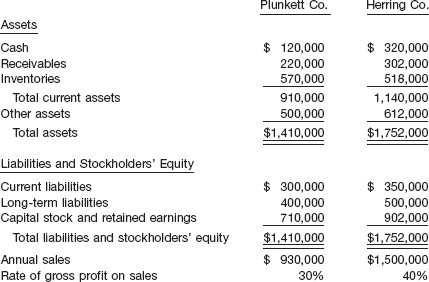
Each of these companies has requested a loan of $50,000 for 6 months with no collateral offered. Inasmuch as your bank has reached its quota for loans of this type, only one of these requests is to be granted.
Instructions
Which of the two companies, as judged by the information given above, would you recommend as the better risk and why? Assume that the ending account balances are representative of the entire year.

The president of Robbins Company has asked the controller to prepare a report that summarizes the financial aspects of the company's operations for the past 3 years. This report will be presented to the board of directors at their next meeting.
In addition to comparative financial statements, the controller has decided to present a number of relevant financial ratios which can assist in the identification and interpretation of trends. At the request of the controller, the accounting staff has calculated the following ratios for the 3-year period 2009–2011.
2009
2010
2011
Current ratio
1.80
1.89
1.96
Acid-test (quick) ratio
1.04
0.99
0.87
Accounts receivable turnover
8.75
7.71
6.42
Inventory turnover
4.91
4.32
3.72
Total debt to total assets
51.0%
46.0%
41.0%
Long-term debt to total assets
31.0%
27.0%
24.0%
Sales to fixed assets (fixed asset turnover)
1.58
1.69
1.79
Sales as a percent of 2009 sales
1.00
1.03
1.05
Gross margin percentage
36.0%
35.1%
34.6%
Net income to sales
6.9%
7.0%
7.2%
Return on total assets
7.7%
7.7%
7.8%
Return on stockholders' equity
13.6%
13.1%
12.7%
In preparation of the report, the controller has decided first to examine the financial ratios independent of any other data to determine if the ratios themselves reveal any significant trends over the 3-year period.
Instructions
The current ratio is increasing while the acid-test (quick) ratio is decreasing. Using the ratios provided, identify and explain the contributing factor(s) for this apparently divergent trend.
In terms of the ratios provided, what conclusion(s) can be drawn regarding the company's use of financial leverage during the 2009–2011 period?
Using the ratios provided, what conclusion(s) can be drawn regarding the company's net investment in plant and equipment?


Howser is being reviewed by several entities whose interests vary, and the company's financial ratios are a part of the data being considered. Each of the parties listed below must recommend an action based on its evaluation of Howser's financial position.
Citizens National Bank. The bank is processing Howser's application for a new 5-year term note. Citizens National has been Howser's banker for several years but must reevaluate the company's financial position for each major transaction.
Charleston Company. Charleston is a new supplier to Howser and must decide on the appropriate credit terms to extend to the company.
Shannon Financial. A brokerage firm specializing in the stock of electronics firms that are sold over-the-counter, Shannon Financial must decide if it will include Howser in a new fund being established for sale to Shannon Financial's clients.
Working Capital Management Committee. This is a committee of Howser's management personnel chaired by the chief operating officer. The committee is charged with the responsibility of periodically reviewing the company's working capital position, comparing actual data against budgets, and recommending changes in strategy as needed.
Instructions
Describe the analytical use of each of the six ratios presented above.
For each of the four entities described above, identify two financial ratios, from those ratios presented in Illustration 24A-1 (on page 1351), that would be most valuable as a basis for its decision regarding Howser.
Discuss what the financial ratios presented in the question reveal about Howser. Support your answer by citing specific ratio levels and trends as well as the interrelationships between these ratios.
(CMA adapted)



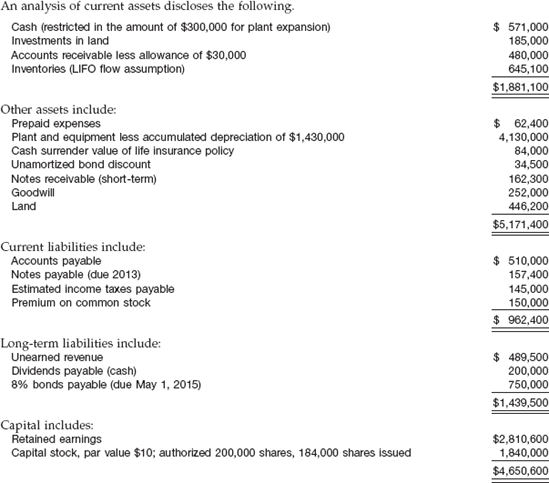
The supplementary information below is also provided.
On May 1, 2010, the corporation issued at 95.4, $750,000 of bonds to finance plant expansion. The long-term bond agreement provided for the annual payment of interest every May 1. The existing plant was pledged as security for the loan. Use the straight-line method for discount amortization.
The bookkeeper made the following mistakes.
In 2008, the ending inventory was overstated by $183,000. The ending inventories for 2009 and 2010 were correctly computed.
In 2010, accrued wages in the amount of $225,000 were omitted from the balance sheet, and these expenses were not charged on the income statement.
In 2010, a gain of $175,000 (net of tax) on the sale of certain plant assets was credited directly to retained earnings.
A major competitor has introduced a line of products that will compete directly with Almaden's primary line, now being produced in a specially designed new plant. Because of manufacturing innovations, the competitor's line will be of comparable quality but priced 50% below Almaden's line. The competitor announced its new line on January 14, 2011. Almaden indicates that the company will meet the lower prices that are high enough to cover variable manufacturing and selling expenses, but permit recovery of only a portion of fixed costs.
You learned on January 28, 2011, prior to completion of the audit, of heavy damage because of a recent fire to one of Almaden's two plants; the loss will not be reimbursed by insurance. The newspapers described the event in detail.
Instructions
Analyze the above information to prepare a corrected balance sheet for Almaden in accordance with proper accounting and reporting principles. Prepare a description of any notes that might need to be prepared. The books are closed and adjustments to income are to be made through retained earnings.


Sales of segments B and C included intersegment sales of $20,000 and $100,000, respectively.
Instructions
Determine which of the segments are reportable based on the:
Revenue test.
Operating profit (loss) test.
Identifiable assets test.
Prepare the necessary disclosures required by GAAP.

The commercial loan officer of Topeka National Bank requested financial reports for the last 2 fiscal years. These reports are reproduced on page 1369.

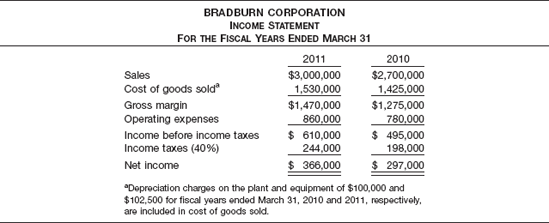
Instructions
Compute the following items for Bradburn Corporation.
Current ratio for fiscal years 2010 and 2011.
Acid-test (quick) ratio for fiscal years 2010 and 2011.
Inventory turnover for fiscal year 2011.
Return on assets for fiscal years 2010 and 2011. (Assume total assets were $1,688,500 at 3/31/09.)
Percentage change in sales, cost of goods sold, gross margin, and net income after taxes from fiscal year 2010 to 2011.
Identify and explain what other financial reports and/or financial analyses might be helpful to the commercial loan officer of Topeka National Bank in evaluating Daniel Brown's request for a time extension on Bradburn's notes.
Assume that the percentage changes experienced in fiscal year 2011 as compared with fiscal year 2010 for sales and cost of goods sold will be repeated in each of the next 2 years. Is Bradburn's desire to finance the plant expansion from internally generated funds realistic? Discuss.
Should Topeka National Bank grant the extension on Bradburn's notes considering Daniel Brown's statement about financing the plant expansion through internally generated funds? Discuss.

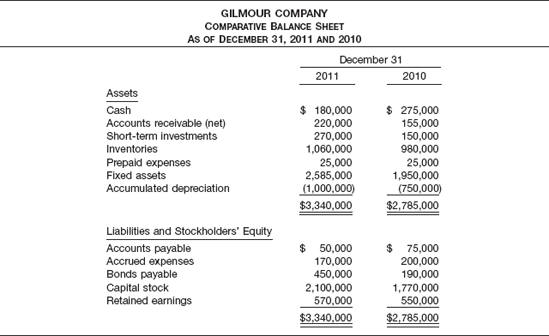
Instructions
(Round to two decimal places.)
Prepare a comparative balance sheet of Gilmour Company showing the percent each item is of the total assets or total liabilities and stockholders' equity.
Prepare a comparative balance sheet of Gilmour Company showing the dollar change and the percent change for each item.
Of what value is the additional information provided in part (a)?
Of what value is the additional information provided in part (b)?


Instructions
Suggest factors to be considered by the board of directors in establishing a dividend policy.
Compute the rate of return on assets, profit margin on sales, earnings per share, price-earnings ratio, and current ratio for each of the 5 years for Matheny Inc.
Comment on the appropriateness of declaring a cash dividend at this time, using the ratios computed in part (b) as a major factor in your analysis.
CA24-1 (General Disclosures; Inventories; Property, Plant, and Equipment) Koch Corporation is in the process of preparing its annual financial statements for the fiscal year ended April 30, 2011. Because all of Koch's shares are traded intrastate, the company does not have to file any reports with the Securities and Exchange Commission. The company manufactures plastic, glass, and paper containers for sale to food and drink manufacturers and distributors.
Koch Corporation maintains separate control accounts for its raw materials, work-in-process, and finished goods inventories for each of the three types of containers. The inventories are valued at the lower-of-cost-or-market.
The company's property, plant, and equipment are classified in the following major categories: land, office buildings, furniture and fixtures, manufacturing facilities, manufacturing equipment, and leasehold improvements. All fixed assets are carried at cost. The depreciation methods employed depend on the type of asset (its classification) and when it was acquired.
Koch Corporation plans to present the inventory and fixed asset amounts in its April 30, 2011, balance sheet as shown below.
Inventories
$4,814,200
Property, plant, and equipment (net of depreciation)
6,310,000
Instructions
What information regarding inventories and property, plant, and equipment must be disclosed by Koch Corporation in the audited financial statements issued to stockholders, either in the body or the notes, for the 2010–2011 fiscal year?
(CMA adapted)
CA24-2 (Disclosures Required in Various Situations) Ace Inc. produces electronic components for sale to manufacturers of radios, television sets, and digital sound systems. In connection with her examination of Ace's financial statements for the year ended December 31, 2011, Gloria Rodd, CPA, completed field work 2 weeks ago. Ms. Rodd now is evaluating the significance of the following items prior to preparing her auditor's report. Except as noted, none of these items have been disclosed in the financial statements or notes.
Item 1
A 10-year loan agreement, which the company entered into 3 years ago, provides that dividend payments may not exceed net income earned after taxes subsequent to the date of the agreement. The balance of retained earnings at the date of the loan agreement was $420,000. From that date through December 31, 2011, net income after taxes has totaled $570,000 and cash dividends have totaled $320,000. On the basis of these data, the staff auditor assigned to this review concluded that there was no retained earnings restriction at December 31, 2011.
Item 2
Recently Ace interrupted its policy of paying cash dividends quarterly to its stockholders. Dividends were paid regularly through 2010, discontinued for all of 2011 to finance purchase of equipment for the company's new plant, and resumed in the first quarter of 2012. In the annual report dividend policy is to be discussed in the president's letter to stockholders.
Item 3
A major electronics firm has introduced a line of products that will compete directly with Ace's primary line, now being produced in the specially designed new plant. Because of manufacturing innovations, the competitor's line will be of comparable quality but priced 50% below Ace's line. The competitor announced its new line during the week following completion of field work. Ms. Rodd read the announcement in the newspaper and discussed the situation by telephone with Ace executives. Ace will meet the lower prices that are high enough to cover variable manufacturing and selling expenses but will permit recovery of only a portion of fixed costs.
Item 4
The company's new manufacturing plant building, which cost $2,400,000 and has an estimated life of 25 years, is leased from Wichita National Bank at an annual rental of $600,000. The company is obligated to pay property taxes, insurance, and maintenance. At the conclusion of its 10-year noncancellable lease, the company has the option of purchasing the property for $1. In Ace's income statement, the rental payment is reported on a separate line.
Instructions
For each of the items on page 1371, discuss any additional disclosures in the financial statements and notes that the auditor should recommend to her client. (The cumulative effect of the four items should not be considered.)
CA24-3 (Disclosures, Conditional and Contingent Liabilities) Presented below are three independent situations.
Situation 1
A company offers a one-year warranty for the product that it manufactures. A history of warranty claims has been compiled, and the probable amounts of claims related to sales for a given period can be determined.
Situation 2
Subsequent to the date of a set of financial statements, but prior to the issuance of the financial statements, a company enters into a contract that will probably result in a significant loss to the company. The amount of the loss can be reasonably estimated.
Situation 3
A company has adopted a policy of recording self-insurance for any possible losses resulting from injury to others by the company's vehicles. The premium for an insurance policy for the same risk from an independent insurance company would have an annual cost of $4,000. During the period covered by the financial statements, there were no accidents involving the company's vehicles that resulted in injury to others.
Instructions
Discuss the accrual or type of disclosure necessary (if any) and the reason(s) why such disclosure is appropriate for each of the three independent sets of facts above.
(AICPA adapted)

On February 3, 2011, one of Coburn's customers declared bankruptcy. At December 31, 2010, this company owed Coburn $300,000, of which $60,000 was paid in January, 2011.
On January 18, 2011, one of the three major plants of the client burned.
On January 23, 2011, a strike was called at one of Coburn's largest plants, which halted 30% of its production. As of today (February 13) the strike has not been settled.
A major electronics enterprise has introduced a line of products that would compete directly with Coburn's primary line, now being produced in a specially designed new plant. Because of manufacturing innovations, the competitor has been able to achieve quality similar to that of Coburn's products, but at a price 50% lower. Coburn officials say they will meet the lower prices, which are high enough to cover variable manufacturing and selling costs but which permit recovery of only a portion of fixed costs.
Merchandise traded in the open market is recorded in the company's records at $1.40 per unit on December 31, 2010. This price had prevailed for 2 weeks, after release of an official market report that predicted vastly enlarged supplies; however, no purchases were made at $1.40. The price throughout the preceding year had been about $2, which was the level experienced over several years. On January 18, 2011, the price returned to $2, after public disclosure of an error in the official calculations of the prior December, correction of which destroyed the expectations of excessive supplies. Inventory at December 31, 2010, was on a lower-of-cost-or-market basis.
On February 1, 2011, the board of directors adopted a resolution accepting the offer of an investment banker to guarantee the marketing of $1,200,000 of preferred stock.
Instructions
State in each case how the 2010 financial statements would be affected, if at all.

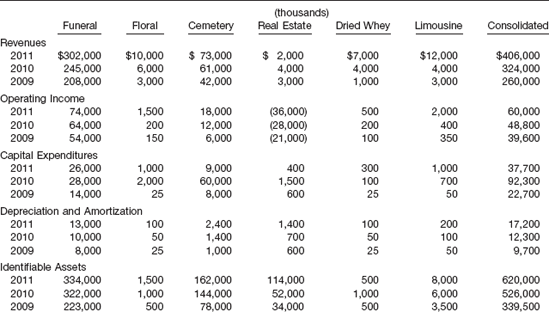
Instructions
Determine which of the above segments must be reported separately and which can be combined under the category "Other." Then, write a one-page memo to the company's accountant, Anthony Reese, explaining the following.
What segments must be reported separately and what segments can be combined.
What criteria you used to determine reportable segments.
What major items for each must be disclosed.
CA24-6 (Segment Reporting—Theory) Presented below is an excerpt from the financial statements of H. J. Heinz Company.
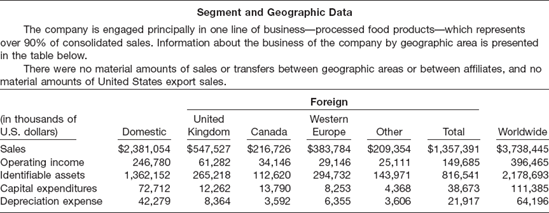
Instructions
Why does H. J. Heinz not prepare segment information on its products or services?
What are export sales, and when should they be disclosed?
Why are sales by geographical area important to disclose?

WASHINGTON—The Securities and Exchange Commission staff issued guidelines for companies grappling with the problem of dividing up their business into industry segments for their annual reports.
An industry segment is defined by the Financial Accounting Standards Board as a part of an enterprise engaged in providing a product or service or a group of related products or services primarily to unaffiliated customers for a profit.
Although conceding that the process is a "subjective task" that "to a considerable extent, depends on the judgment of management," the SEC staff said companies should consider ... various factors ... to determine whether products and services should be grouped together or reported as segments.
Instructions
What does financial reporting for segments of a business enterprise involve?
Identify the reasons for requiring financial data to be reported by segments.
Identify the possible disadvantages of requiring financial data to be reported by segments.
Identify the accounting difficulties inherent in segment reporting.
CA24-8 (Interim Reporting) Snider Corporation, a publicly traded company, is preparing the interim financial data which it will issue to its stockholders and the Securities and Exchange Commission (SEC) at the end of the first quarter of the 2010–2011 fiscal year. Snider's financial accounting department has compiled the following summarized revenue and expense data for the first quarter of the year.
Sales
$60,000,000
Cost of goods sold
36,000,000
Variable selling expenses
1,000,000
Fixed selling expenses
3,000,000
Included in the fixed selling expenses was the single lump-sum payment of $2,000,000 for television advertisements for the entire year.
Instructions
Snider Corporation must issue its quarterly financial statements in accordance with generally accepted accounting principles regarding interim financial reporting.
Explain whether Snider should report its operating results for the quarter as if the quarter were a separate reporting period in and of itself, or as if the quarter were an integral part of the annual reporting period.
State how the sales, cost of goods sold, and fixed selling expenses would be reflected in Snider Corporation's quarterly report prepared for the first quarter of the 2010–2011 fiscal year. Briefly justify your presentation.
What financial information, as a minimum, must Snider Corporation disclose to its stockholders in its quarterly reports?
(CMA adapted)

Interim financial information is essential to provide investors and others with timely information as to the progress of the enterprise. The usefulness of such information rests on the relationship that it has to the annual results of operations. Accordingly, the Board has concluded that each interim period should be viewed primarily as an integral part of an annual period.
In general, the results for each interim period should be based on the accounting principles and practices used by an enterprise in the preparation of its latest annual financial statements unless a change in an accounting practice or policy has been adopted in the current year. The Board has concluded, however, that certain accounting principles and practices followed for annual reporting purposes may require modification at interim reporting dates so that the reported results for the interim period may better relate to the results of operations for the annual period.
Instructions
Listed on page 1375 are six independent cases on how accounting facts might be reported on an individual company's interim financial reports. For each of these cases, state whether the method proposed to be used for interim reporting would be acceptable under generally accepted accounting principles applicable to interim financial data. Support each answer with a brief explanation.
J. D. Long Company takes a physical inventory at year-end for annual financial statement purposes. Inventory and cost of sales reported in the interim quarterly statements are based on estimated gross profit rates, because a physical inventory would result in a cessation of operations. Long Company does have reliable perpetual inventory records.
Rockford Company is planning to report one-fourth of its pension expense each quarter.
Republic Company wrote inventory down to reflect lower-of-cost-or-market in the first quarter. At year-end the market exceeds the original acquisition cost of this inventory. Consequently, management plans to write the inventory back up to its original cost as a year-end adjustment.
Gansner Company realized a large gain on the sale of investments at the beginning of the second quarter. The company wants to report one-third of the gain in each of the remaining quarters.
Fredonia Company has estimated its annual audit fee. It plans to pro rate this expense equally over all four quarters.
LaBrava Company was reasonably certain it would have an employee strike in the third quarter. As a result, it shipped heavily during the second quarter but plans to defer the recognition of the sales in excess of the normal sales volume. The deferred sales will be recognized as sales in the third quarter when the strike is in progress. LaBrava Company management thinks this is more representative of normal second- and third-quarter operations.

Okay. Last fall, someone with a long memory and an even longer arm reached into that bureau drawer and came out with a moldy cheese sandwich and the equally moldy notion of corporate forecasts. We tried to find out what happened to the cheese sandwich—but, rats!, even recourse to the Freedom of Information Act didn't help. However, the forecast proposal was dusted off, polished up and found quite serviceable. The SEC, indeed, lost no time in running it up the old flagpole—but no one was very eager to salute. Even after some of the more objectionable features—compulsory corrections and detailed explanations of why the estimates went awry—were peeled off the original proposal.
Seemingly, despite the Commission's smiles and sweet talk, those craven corporations were still afraid that an honest mistake would lead them down the primrose path to consent decrees and class action suits. To lay to rest such qualms, the Commission last week approved a "Safe Harbor" rule that, providing the forecasts were made on a reasonable basis and in good faith, protected corporations from litigation should the projections prove wide of the mark (as only about 99% are apt to do).
Instructions
What are the arguments for preparing profit forecasts?
What is the purpose of the "safe harbor" rule?
Why are corporations concerned about presenting profit forecasts?

Instructions
What, if any, is the ethical dilemma in this situation?
Should Lilly, the controller, remain silent? Give reasons.
What stakeholders might be affected by Tercek's media release?
Give your opinion on the following statement and cite reasons: "Because Tercek, the vice president, is most directly responsible for the media release, Lilly has no real responsibility in this matter."

Instructions
What are the ethical issues involved?
Should McElroy agree to the delay?

Each numbered transaction is to be considered completely independent of the others, and its related answer should be based on the effect(s) of that transaction alone. Assume that all numbered transactions occurred during 2011 and that the amount involved in each case is sufficiently material to distort reported net income if improperly included in the determination of net income. Assume further that each transaction was recorded in accordance with generally accepted accounting principles and, where applicable, in conformity with the all-inclusive concept of the income statement.
For each of the numbered transactions you are to decide whether it:
Increased the corporation's 2011 net income.
Decreased the corporation's 2011 net income.
Increased the corporation's total retained earnings directly (i.e., not via net income).
Decreased the corporation's total retained earnings directly.
Increased the corporation's current ratio.
Decreased the corporation's current ratio.
Increased each stockholder's proportionate share of total stockholders' equity.
Decreased each stockholder's proportionate share of total stockholders' equity.
Increased each stockholder's equity per share of stock (book value).
Decreased each stockholder's equity per share of stock (book value).
Had none of the foregoing effects.
Instructions
List the numbers 1 through 9. Select as many letters as you deem appropriate to reflect the effect(s) of each transaction as of the date of the transaction by printing beside the transaction number the letter(s) that identifies that transaction's effect(s).
Transactions
_____1. In January the board directed the write-off of certain patent rights that had suddenly and unexpectedly become worthless.
_____2. The corporation sold at a profit land and a building that had been idle for some time. Under the terms of the sale, the corporation received a portion of the sales price in cash immediately, the balance maturing at 6-month intervals.
_____3. Treasury stock originally repurchased and carried at $127 per share was sold for cash at $153 per share.
_____4. The corporation wrote off all of the unamortized discount and issue expense applicable to bonds that it refinanced in 2011.
_____5. The corporation called in all its outstanding shares of stock and exchanged them for new shares on a 2-for-1 basis, reducing the par value at the same time to $50 per share.
_____6. The corporation paid a cash dividend that had been recorded in the accounts at time of declaration.
_____7. Litigation involving Wainwright Inc. as defendant was settled in the corporation's favor, with the plaintiff paying all court costs and legal fees. In 2008 the corporation had appropriately established a special contingency for this court action. (Indicate the effect of reversing the contingency only.)
_____8. The corporation received a check for the proceeds of an insurance policy from the company with which it is insured against theft of trucks. No entries concerning the theft had been made previously, and the proceeds reduce but do not cover completely the loss.
_____9. Treasury stock, which had been repurchased at and carried at $127 per share, was issued as a stock dividend. In connection with this distribution, the board of directors of Wainwright Inc. had authorized a transfer from retained earnings to permanent capital of an amount equal to the aggregate market value ($153 per share) of the shares issued. No entries relating to this dividend had been made previously.
(AICPA adapted)

As stated in the chapter, notes to the financial statements are the means of explaining the items presented in the main body of the statements. Common note disclosures relate to such items as accounting policies, segmented information, and interim reporting. The financial statements of P&G are provided in Appendix 5B or can be accessed at the book's companion website, www.wiley.com/college/kieso.
Instructions
Refer to P&G's financial statements and the accompanying notes to answer the following questions.

For what segments did P&G report segmented information? Which segment is the largest? Who is P&G largest customer?
What interim information was reported by P&G?
Instructions
Go to the book's companion website and use information found there to answer the following questions related to The Coca-Cola Company and PepsiCo, Inc.

What specific items does Coca-Cola discuss in its Note 1—Accounting Policies? (Prepare a list of the headings only.)
What specific items does PepsiCo discuss in its Note 2—Our Summary of Significant Accounting Policies? (Prepare a list of the headings only.)
For what lines of business or segments do Coca-Cola and PepsiCo present segmented information?
Note and comment on the similarities and differences between the auditors' reports submitted by the independent auditors of Coca-Cola and PepsiCo for the year 2007.
RNA Inc. manufactures a variety of consumer products. The company's founders have run the company for 30 years and are now interested in retiring. Consequently, they are seeking a purchaser who will continue its operations, and a group of investors, Morgan Inc., is looking into the acquisition of RNA. To evaluate its financial stability and operating efficiency, RNA was requested to provide the latest financial statements and selected financial ratios. Summary information provided by RNA is presented on the next page.
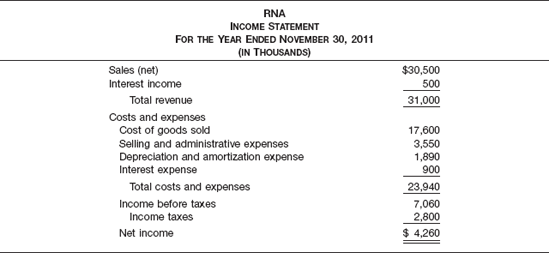


Instructions
Calculate a new set of ratios for the fiscal year 2011 for RNA based on the financial statements presented.
Explain the analytical use of each of the seven ratios presented, describing what the investors can learn about RNA's financial stability and operating efficiency.
Identify two limitations of ratio analysis.
(CMA adapted)
As part of the year-end audit, you are discussing the disclosure checklist with your client. The checklist identifies the items that must be disclosed in a set of GAAP financial statements. The client is surprised by the disclosure item related to accounting policies. Specifically, since the audit report will attest to the statements being prepared in accordance with GAAP, the client questions the accounting policy checklist item. The client has asked you to conduct some research to verify the accounting policy disclosures.
Instructions
Access the FASB Codification at http://asc.fasb.org/home to conduct research using the Codification Research System to prepare responses to the following items. Provide Codification references for your responses.
In general, what should disclosures of accounting policies encompass?
List some examples of the most commonly required disclosures.
[425] Aliya Sternstein, "Heavy Lifting Required," Forbes (October 13, 2003) p. 58.
[426] The FASB has had a disclosure-effectiveness project. The revised pension and postretirement benefit disclosures discussed in Chapter 20 are one example of how disclosures can be streamlined and made more useful. However, as noted by one FASB member, the usefulness of expanded required disclosure also depends on users' ability to distinguish between disclosed versus recognized items in financial statements. Research to date is inconclusive on this matter. See Katherine Schipper, "Required Disclosures in Financial Reports," Presidential Address to the American Accounting Association Annual Meeting; San Francisco, CA (August 2005).
[427] In response to cost-benefit concerns, the SEC has exempted some small public companies from certain rules implemented in response to the Sarbanes-Oxley Act of 2002. For example, smaller companies have more time to comply with the internal control rules required by the Sarbanes-Oxley law and have more time to file annual and interim reports. Both the FASB and the AICPA are studying the big GAAP/little GAAP issue to ensure that any kind of differential reporting is conceptually sound and meets the needs of users. See Remarks of Robert H. Herz, Chairman, Financial Accounting Standards Board, 2004 AICPA National Conference on Current SEC and PCAOB Reporting Developments (December 7, 2004).
[428] Examples of related-party transactions include transactions between (a) a parent company and its subsidiaries; (b) subsidiaries of a common parent; (c) a company and trusts for the benefit of employees (controlled or managed by the enterprise); and (d) a company and its principal owners, management, or members of immediate families, and affiliates. Two classic cases of related-party transactions were Enron, with its misuse of special purpose entities, and Tyco International, which forgave loans to its management team.
[429] "Consideration of Fraud in a Financial Statement Audit," Statement on Auditing Standards No. 99 (New York, AICPA, 2002). We have an expanded discussion of fraudulent financial reporting later in this chapter. Since passage of the Sarbanes-Oxley Act of 2002, auditors of public companies are regulated by the Public Company Accounting Oversight Board (PCAOB). The PCAOB is now the audit standard-setter for auditors of public companies. It has adopted much of the prior auditing standards issued by the Auditing Standards Board of the AICPA.
[430] The profession became so concerned with certain management frauds that affect financial statements that it established a National Commission on Fraudulent Financial Reporting. The major purpose of this organization was to determine how fraudulent reporting practices could be constrained. Fraudulent financial reporting is discussed later in this chapter.
[431] "Illegal Acts by Clients," Statement on Auditing Standards No. 54 (New York, AICPA, 1988).
[432] The effects from natural disasters, like hurricanes Katrina and Rita, which occurred after the year-end for companies with August fiscal years, require disclosure in order to keep the statements from being misleading. Some companies may have to consider whether these disasters affect their ability to continue as going concerns. Accounting Trends and Techniques— 2007 listed the following types of subsequent events and their frequency of occurrence among the 600 companies surveyed: business combinations pending or effected, 94; debt incurred, reduced or refinanced, 63; discontinued operations or asset disposals, 60; litigation, 42; restructuring/bankruptcy, 28; capital stock issued or purchased, 27; stock splits or dividends, 18; and employee benefits, 12.
[433] The estimated annual effective tax rate should reflect anticipated tax credits, foreign tax rates, percentage depletion, capital gains rates, and other available tax-planning alternatives.
[434] "Ordinary" income (or loss) refers to "income (or loss) from continuing operations before income taxes (or benefits)" excluding extraordinary items and discontinued operations.
[435] "Interim Financial Information," Statement on Auditing Standards No. 101 (New York, AICPA, 2002).
[436] A step in this direction is the SEC's mandate for companies to file their financial statements electronically with the SEC. The system, called EDGAR (electronic data gathering and retrieval) provides interested parties with computer access to financial information such as periodic filings, corporate prospectuses, and proxy materials.
[437] This auditor's report is in exact conformance with the specifications contained in "Reports on Audited Financial Statements," Statement on Auditing Standards No. 58 (New York: AICPA, 1988). The last paragraph refers to the assessment of the company's internal controls, as required by the PCAOB.
[438] See Cautionary Advice Regarding Disclosure about Critical Accounting Policies, Release Nos. 33-8040; 34-45149; FR-60 (Washington, D.C.: SEC); and Proposed Rule: Disclosure in Management's Discussion and Analysis about the Application of Critical Accounting Policies, Release Nos. 33-8098; 34-45907; International Series Release No. 1258; File No. S7-16-02 (Washington, D.C.: SEC).
[439] As indicated in this disclosure, management is responsible for preparing the financial statements and establishing and maintaining an effective system of internal controls. The auditor provides an independent assessment of whether the financial statements are prepared in accordance with GAAP, and for public companies, whether the internal controls are effective (see the audit opinion in Illustration 24-14 on page 1336).
[440] Some areas in which companies are using financial information about the future are equipment lease-versus-buy analysis, analysis of a company's ability to successfully enter new markets, and examination of merger and acquisition opportunities. In addition, companies also prepare forecasts and projections for use by third parties in public offering documents (requiring financial forecasts), tax-oriented investments, and financial feasibility studies. Use of forward-looking data has been enhanced by the increased capability of microcomputers to analyze, compare, and manipulate large quantities of data.
[441] "Financial Forecasts and Projections," and "Guide for Prospective Financial Information," Codification of Statements on Standards for Attestation Engagements (New York: AICPA 2006), pars. 3.04 and 3.05.
[442] The issue is serious. Over a recent three-year period, 8 percent of the companies on the NYSE were sued because of an alleged lack of financial disclosure. Companies complain that they are subject to lawsuits whenever the stock price drops. And as one executive noted, "You can even be sued if the stock price goes up—because you did not disclose the good news fast enough."
[443] Op cit., par. 1.02.
[444] "Safe-Harbor Rule for Projections," Release No. 5993 (Washington: SEC, 1979). The Private Securities Litigation Reform Act of 1995 recognizes that some information that is useful to investors is inherently subject to less certainty or reliability than other information. By providing safe harbor for forward-looking statements, Congress has sought to facilitate access to this information by investors.
[445] The British system, for example, does not permit litigation on forecasted information, and the solicitor (lawyer) is not permitted to work on a contingent fee basis. See "A Case for Forecasting—The British Have Tried It and Find That It Works," World (New York: Peat, Marwick, Mitchell & Co., Autumn 1978), pp. 10–13.
[446] C. Twarowski, "Financial Data 'on Steroids'," Washington Post (August 19, 2008), p. D01. Also, see www.xbrl.org/us/us/BusinessCaseForXBRL.pdf for additional information on XBRL. The FASB has issued a report on electronic dissemination of financial reports. This report summarizes current practice and research conducted on Internet financial reporting. See Business Reporting Research Project, "Electronic Distribution of Business Reporting Information" (Norwalk, Conn.: FASB, 2000).
[447] See "SEC Announces Successor to EDGAR Database," http://www.sec.gov/news/press/2008/2008-179.htm. The SEC has implemented other regulations to ensure that investors get high-quality disclosures. For example, as discussed in Chapter 4, the SEC was concerned that companies may use pro forma reporting to deflect investor attention from bad news. In response, the SEC issued Regulation G, which requires companies to reconcile non-GAAP financial measures to GAAP. This regulation provides investors with a roadmap to analyze adjustments companies make to their GAAP numbers to arrive at pro forma results. [See SEC Regulation G, "Conditions for Use of Non-GAAP Financial Measures," Release No. 33-8176 (March 28, 2003).] Regulation FD (Release Nos. 33-7881) was issued in 2000 to address the concern that some analysts were receiving information sooner than the general public (e.g., during conference calls with analysts when earnings releases were discussed). Regulation FD requires that when relevant information is released, all have equal access to it.
[448] "Report of the National Commission on Fraudulent Financial Reporting" (Washington, D.C., 1987), page 2. Unintentional errors as well as corporate improprieties (such as tax fraud, employee embezzlements, and so on) which do not cause the financial statements to be misleading are excluded from the definition of fraudulent financial reporting.
[449] The discussion in this section is based on the Report of the National Commission on Fraudulent Financial Reporting, pp. 23–24. See "2004 Report to the Nation on Occupational Fraud and Abuse, Association of Certified Fraud Examiners," (www.cfenet.com/pdfs/2004RttN.pdf) for fraudulent financial reporting causes and consequences.
[450] Because the profession believes that the role of the auditor is not well understood outside the profession, much attention has been focused on the expectation gap. The expectation gap is the gap between (1) the expectation of financial statement users concerning the level of assurance they believe the independent auditor provides, and(2) the assurance that the independent auditor actually does provide under generally accepted auditing standards.
[451] "Consideration of Fraud in a Financial Statement Audit," Statement on Auditing Standards No. 99 (New York: AICPA, 2002).
[452] Some analysts use other terms to categorize these ratios. For example, liquidity ratios are sometimes referred to as solvency ratios; activity ratios as turnover or efficiency ratios; and coverage ratios as leverage or capital structure ratios.
[453] Richard E. Cheney, "How Dependable Is the Bottom Line?" The Financial Executive (January 1971), p. 12.
[454] See for example, Eugene A. Imhoff, Jr., Robert C. Lipe, and David W. Wright, "Operating Leases: Impact of Constructive Capitalization," Accounting Horizons (March 1991).
[455] All 600 companies surveyed in Accounting Trends and Techniques—2007 presented comparative 2005 amounts in their 2006 balance sheets and presented comparative 2004 and 2005 amounts in their 2006 income statements.
[456] Adapted from Edmund L. Jenkins, "Global Financial Reporting and the Global Financial Markets," 1999 Financial Executive Summit (Vancouver, B.C., May 28, 1999).
[457] Notable examples are exchanges of nonmonetary assets (discussed in Chapter 10) and accounting changes (discussed in Chapter 22.)
[458] Edmund L. Jenkins, "Global Financial Reporting and the Global Financial Markets," 1999 Financial Executive Summit (Vancouver, B.C., May 28, 1999). See also SEC Concept Release, "International Accounting Standards" (Washington, D.C.: SEC, 2000).
[459] See www.iasb.org/about/constitution.asp.
[460] Effective January 1, 2005, the European Union (EU) required member country companies that list on EU securities exchanges to use IASB standards.
